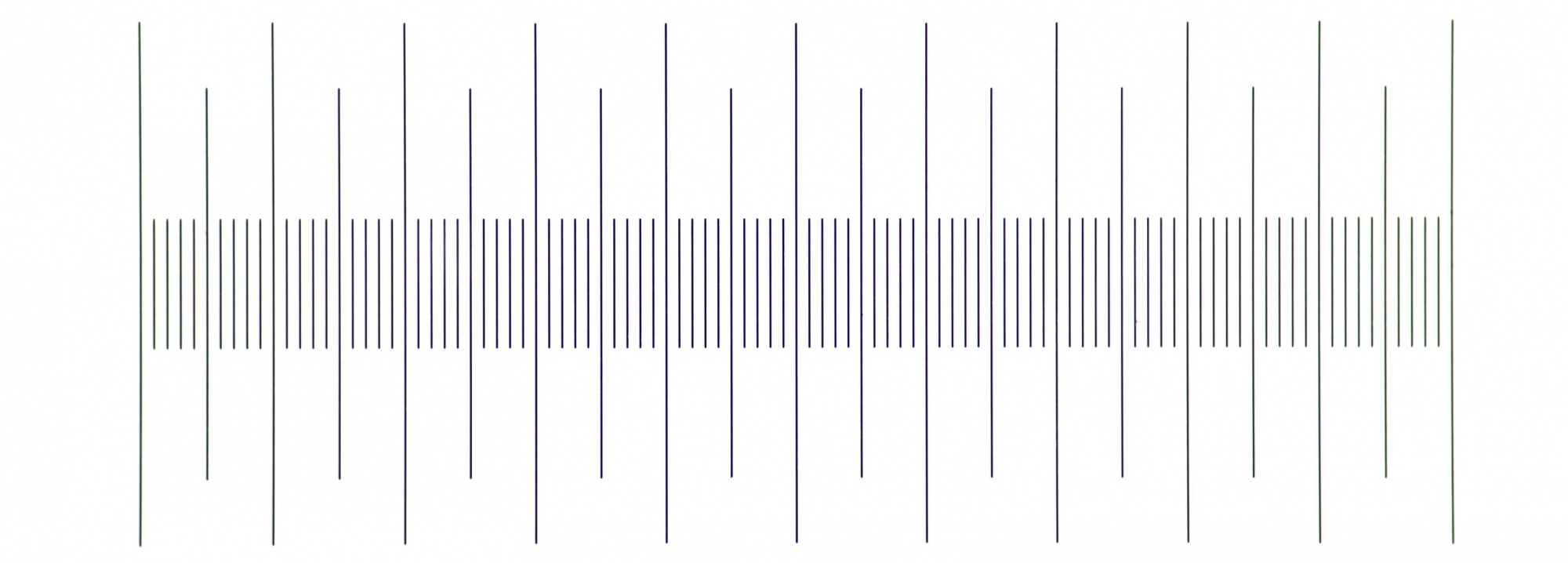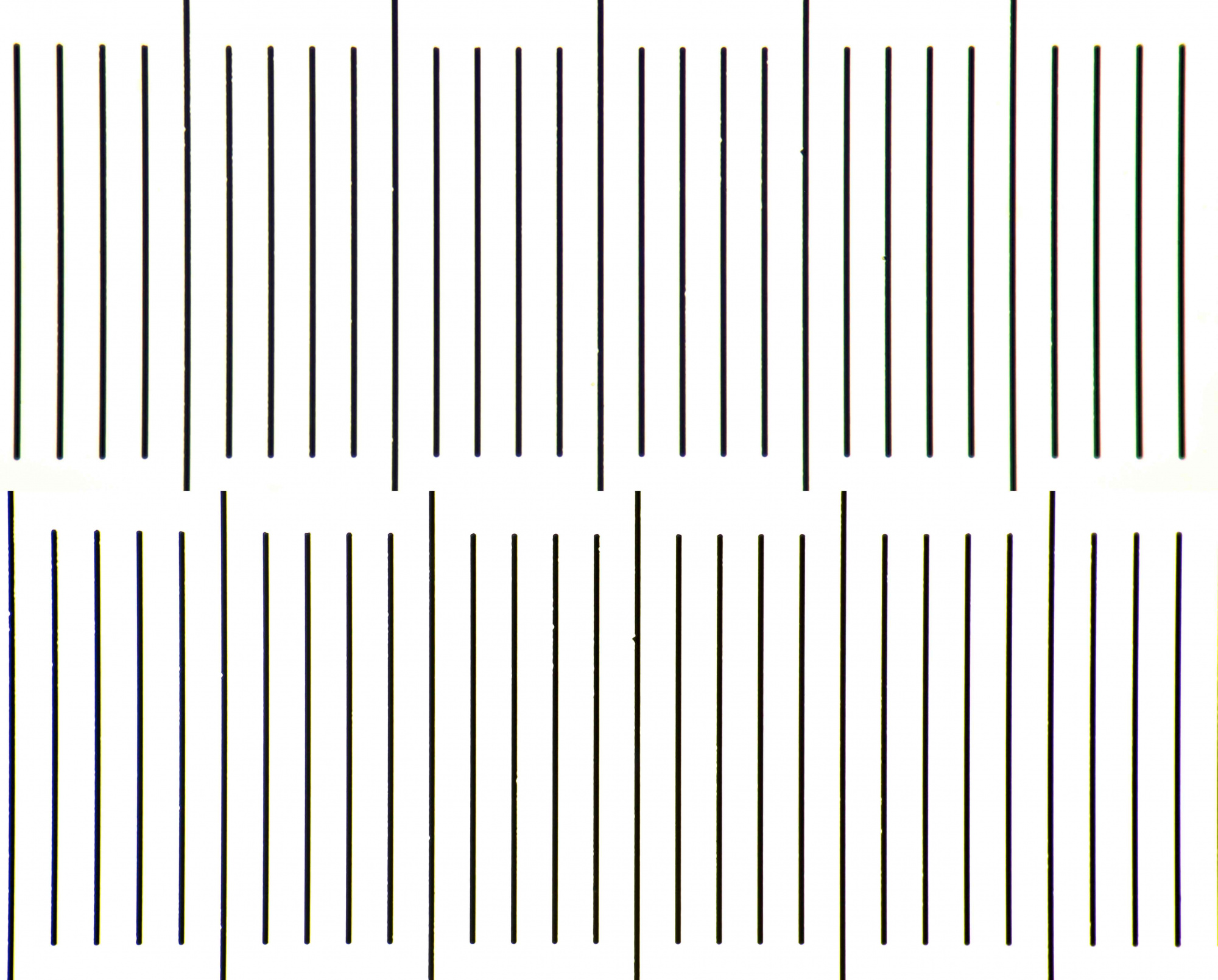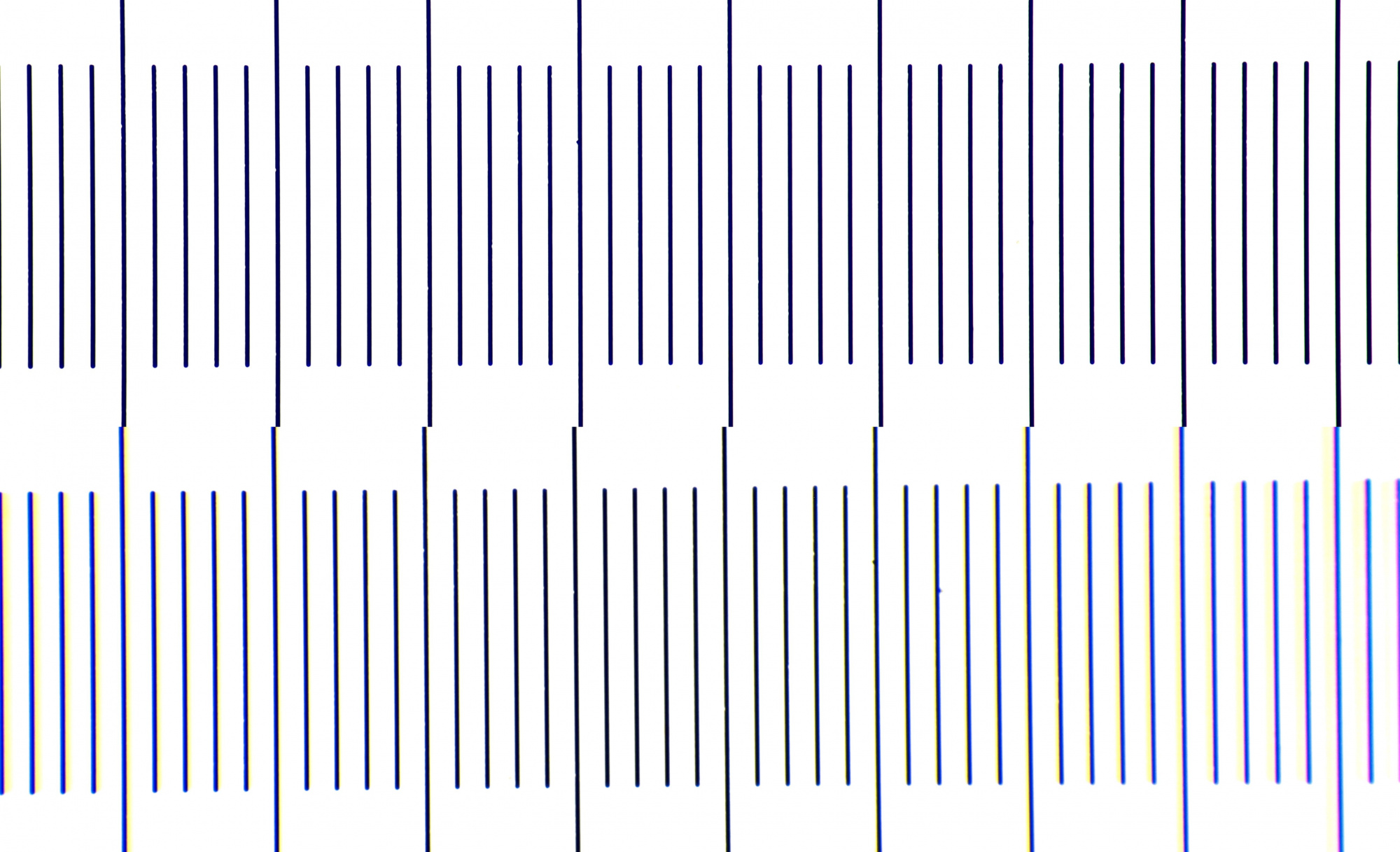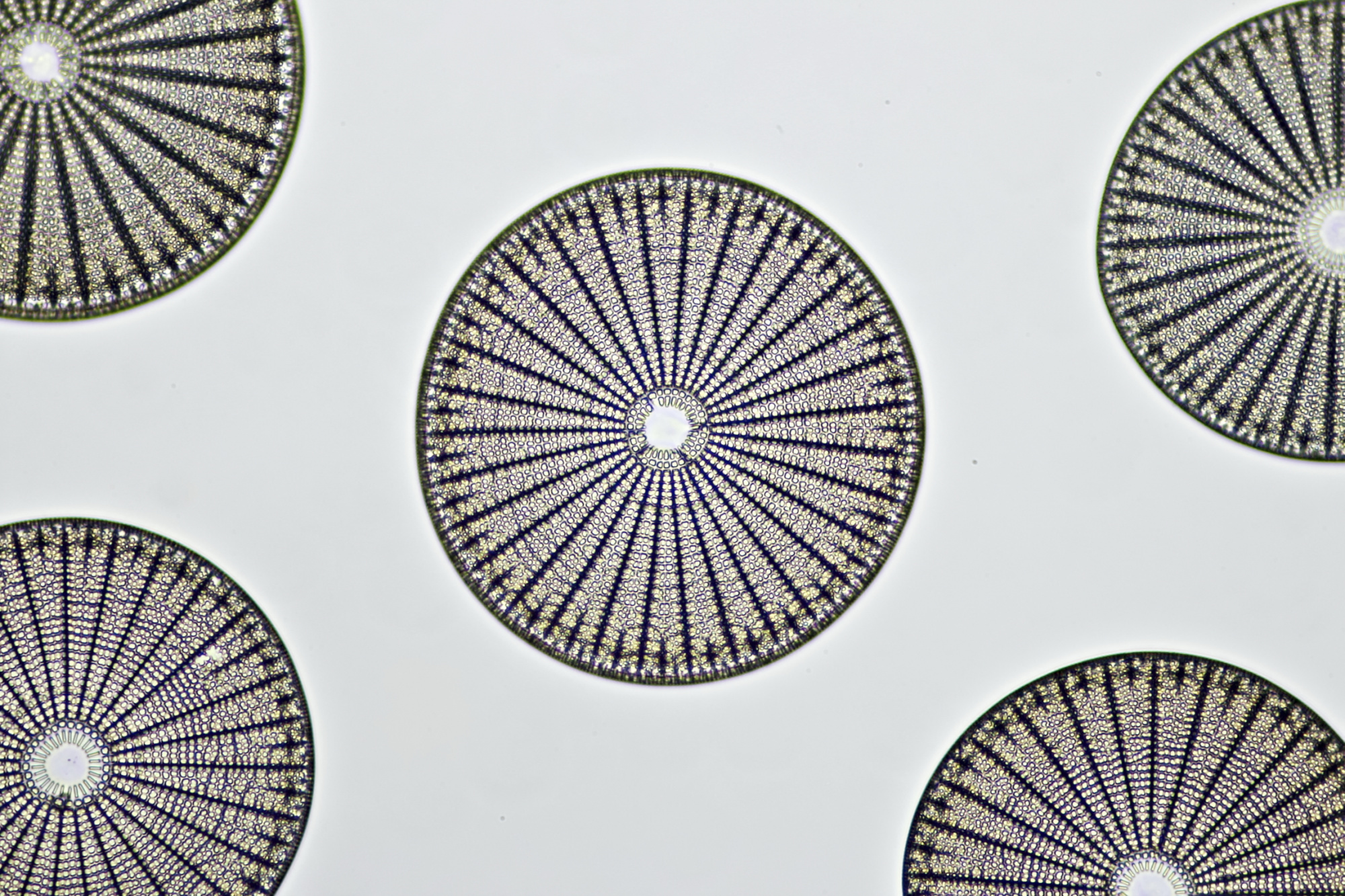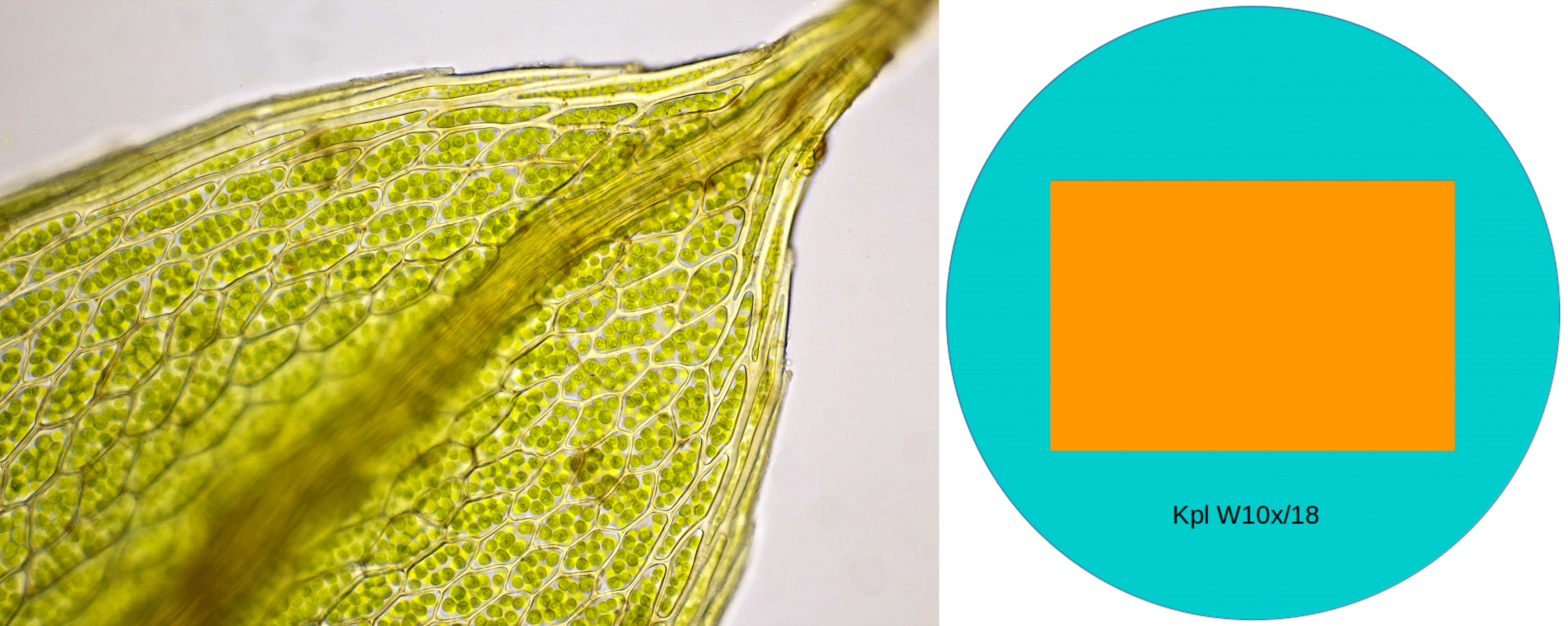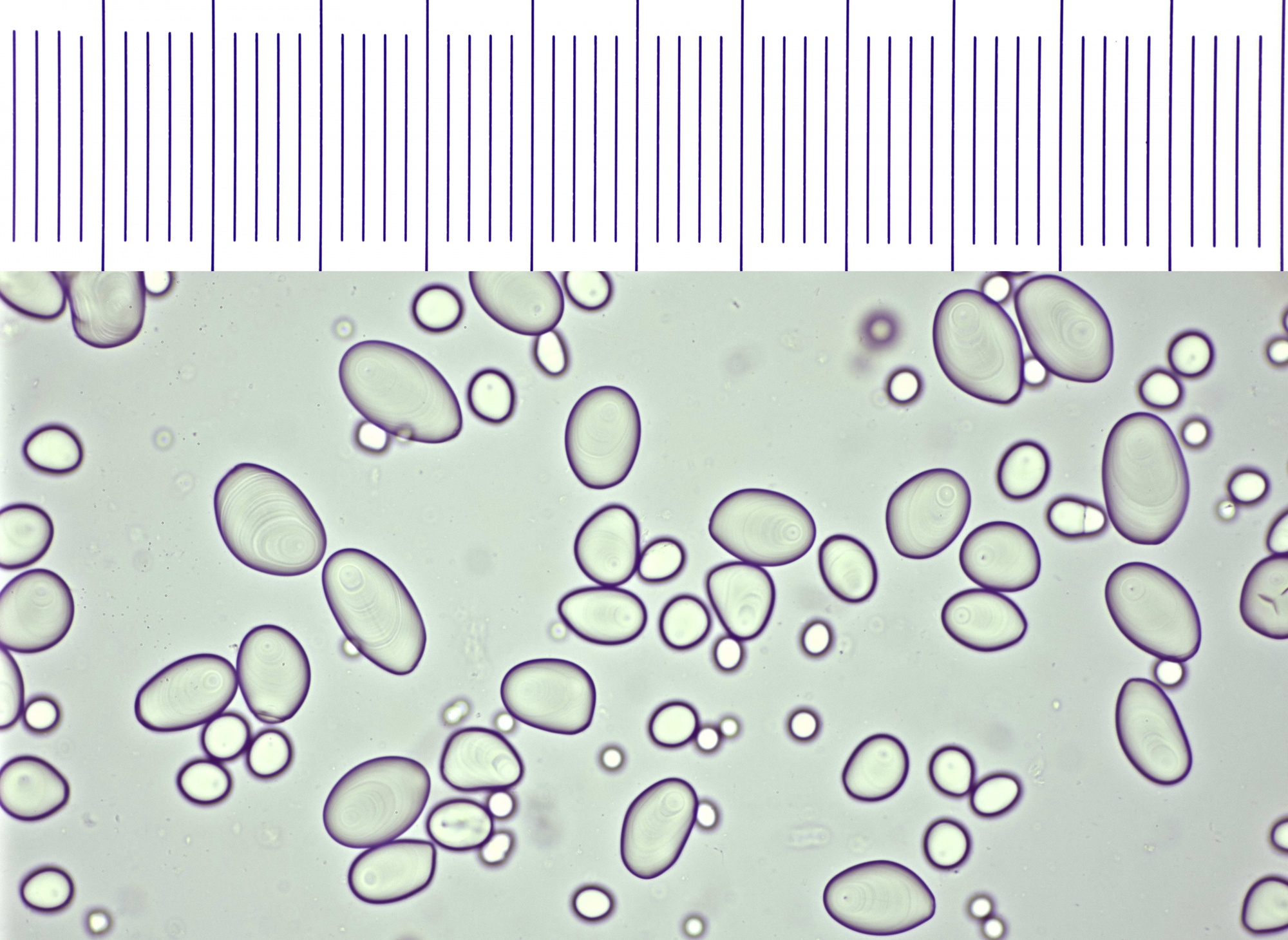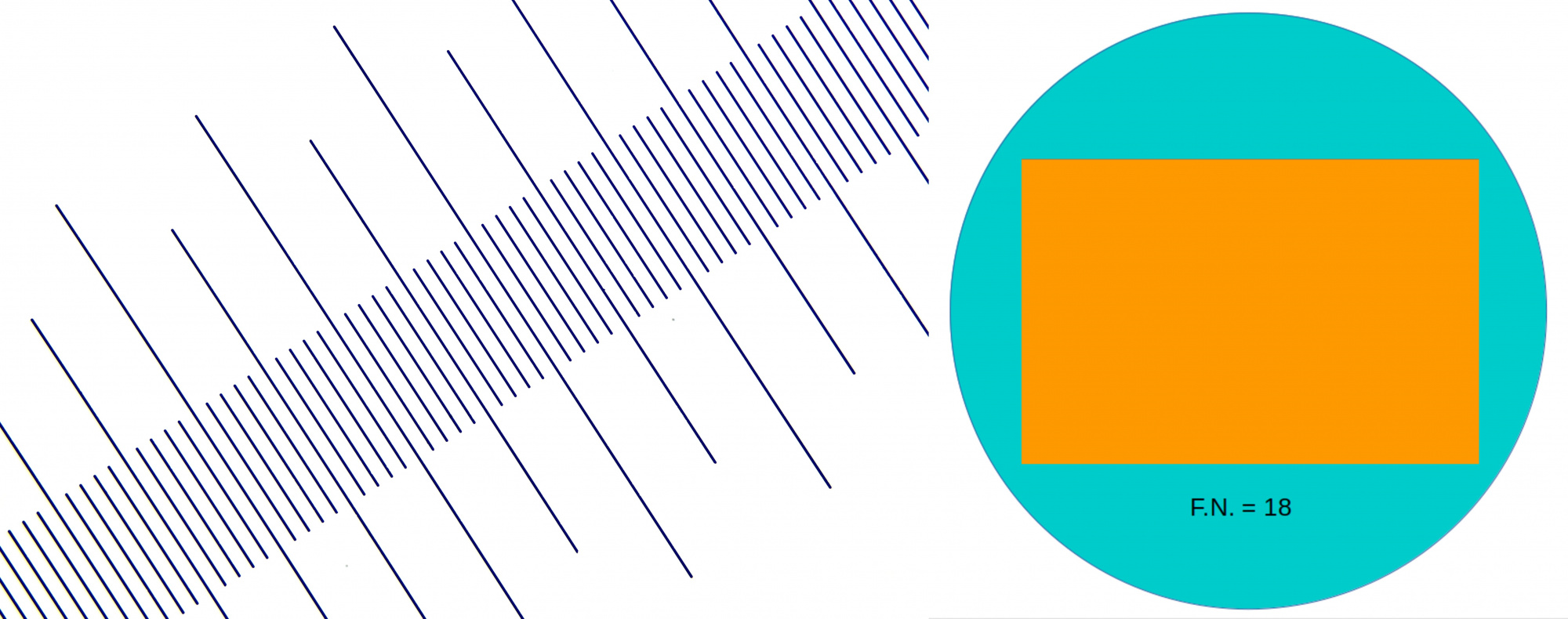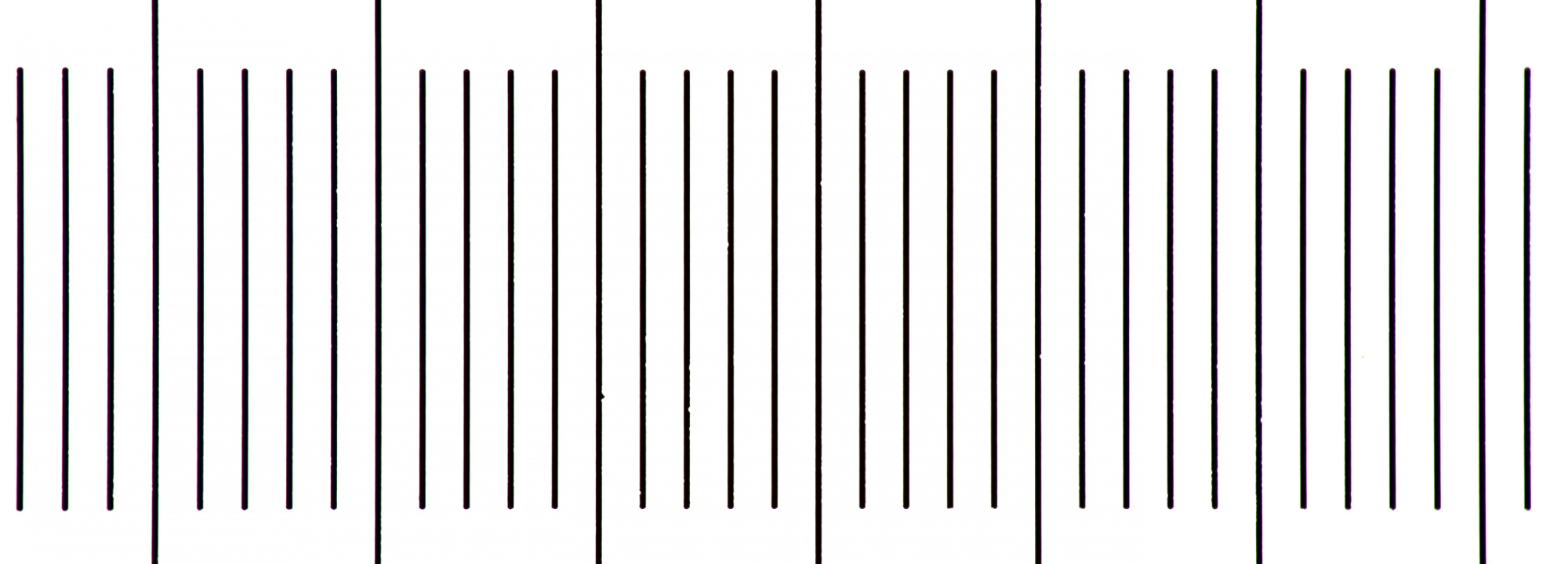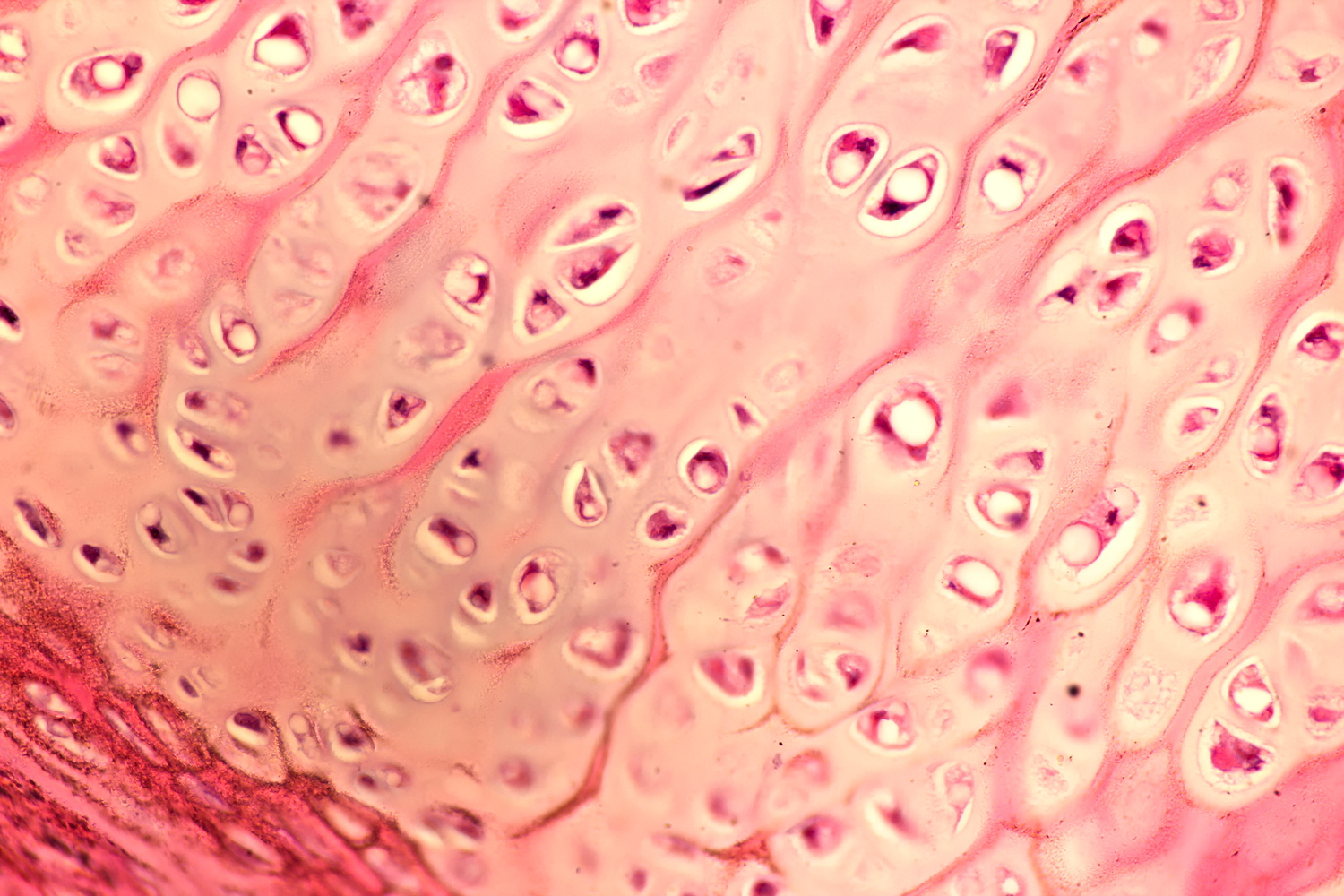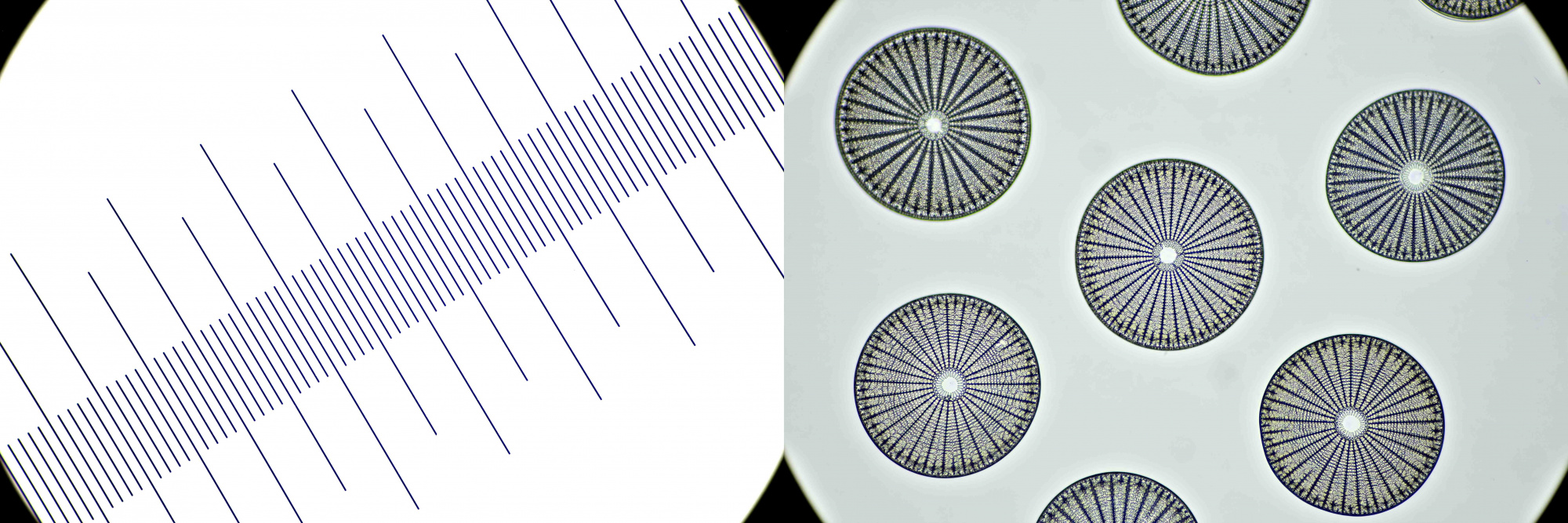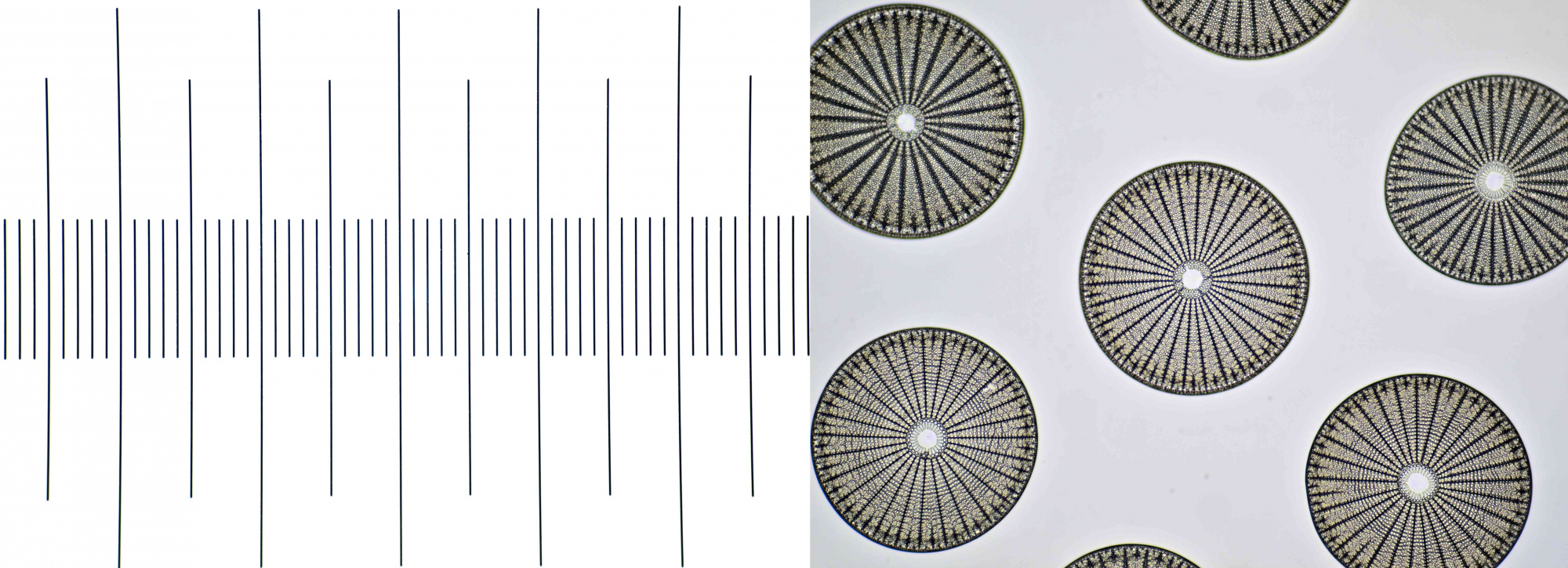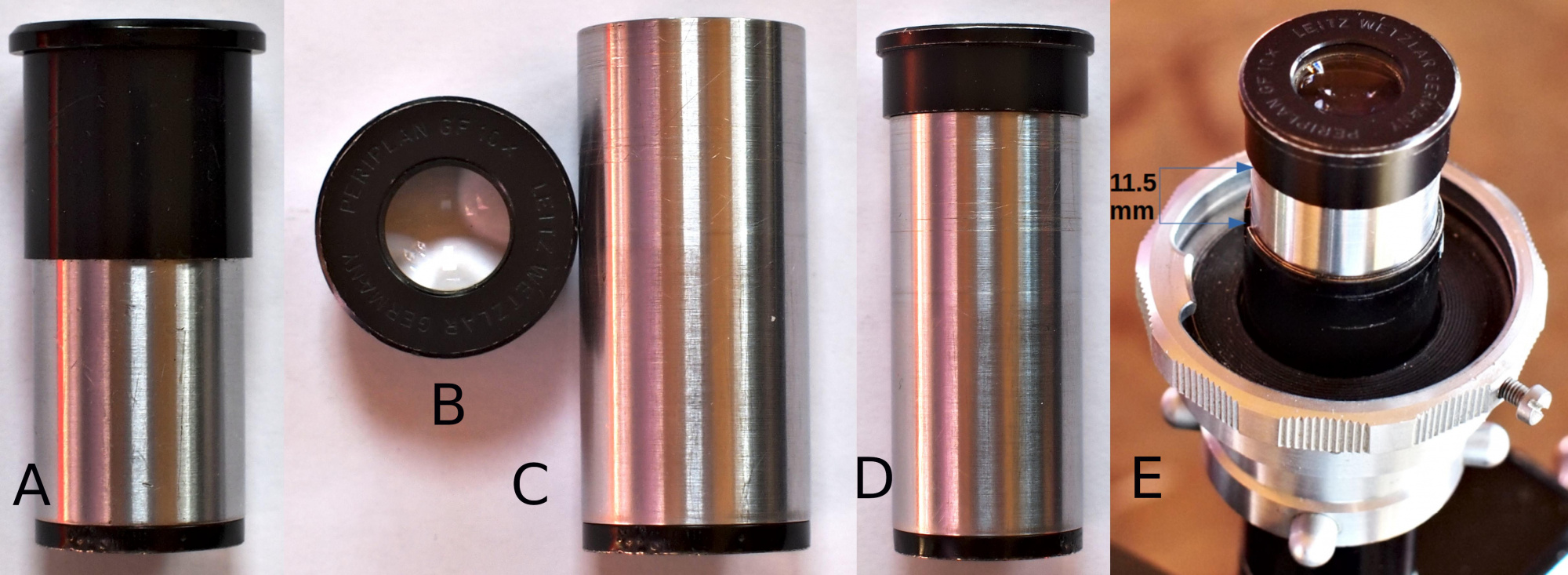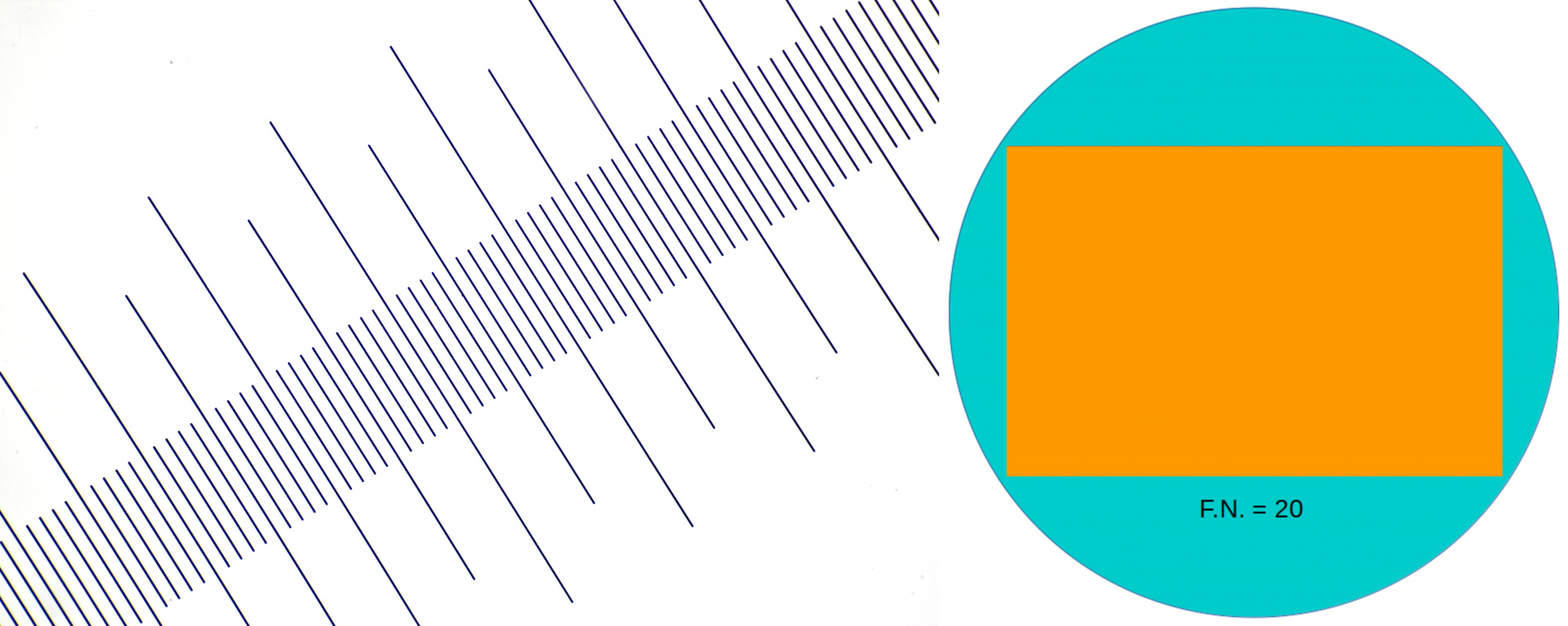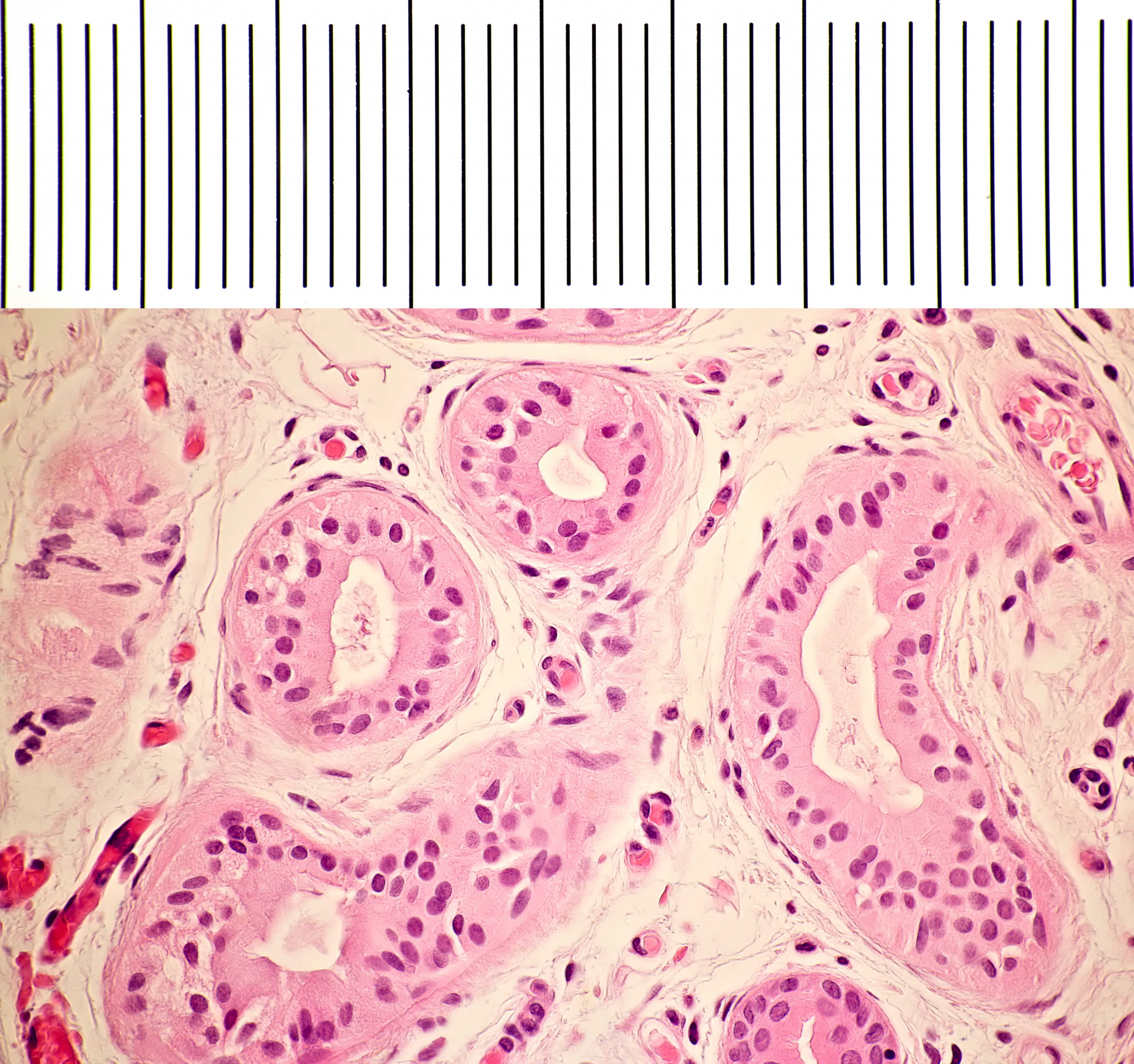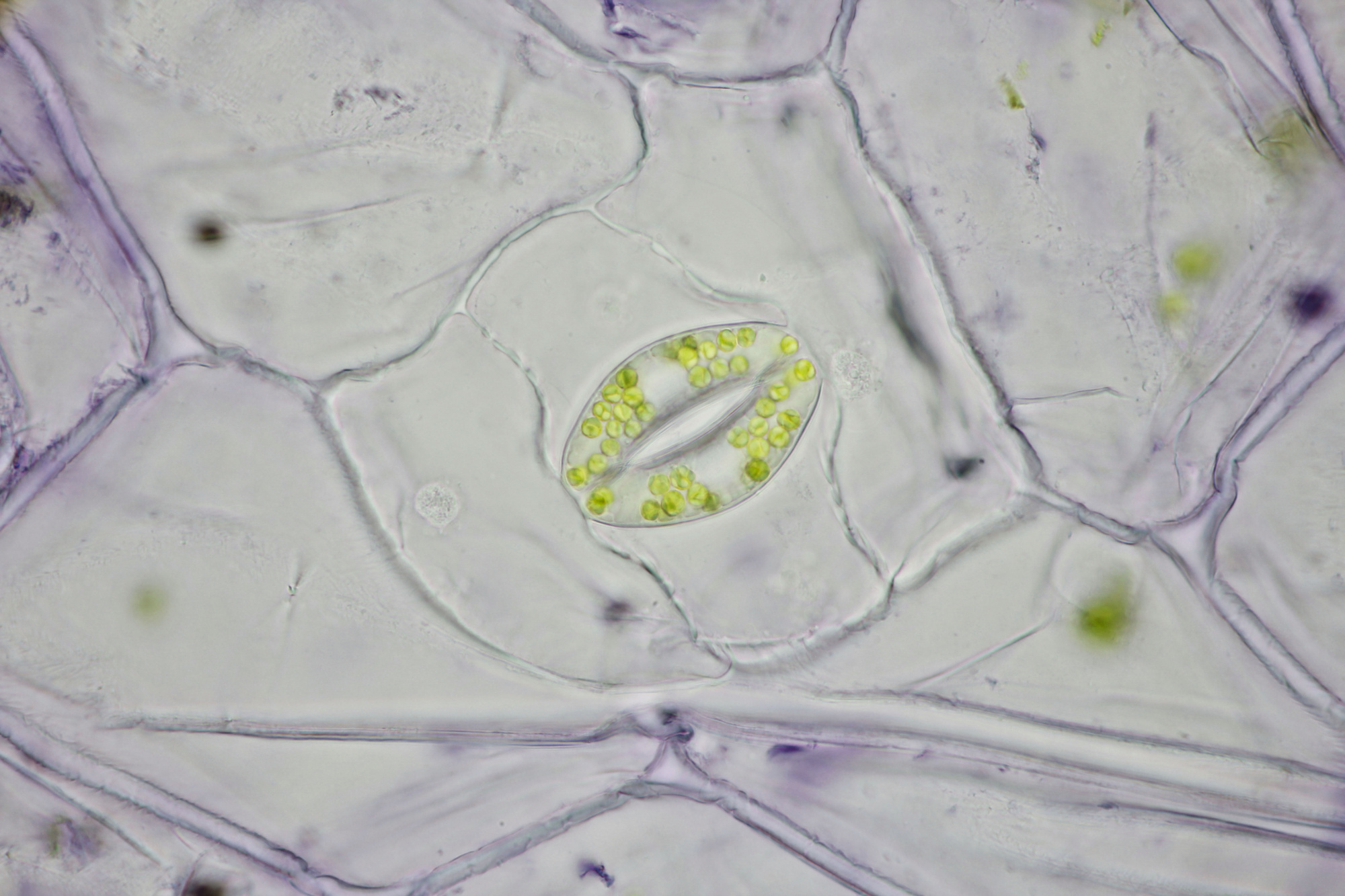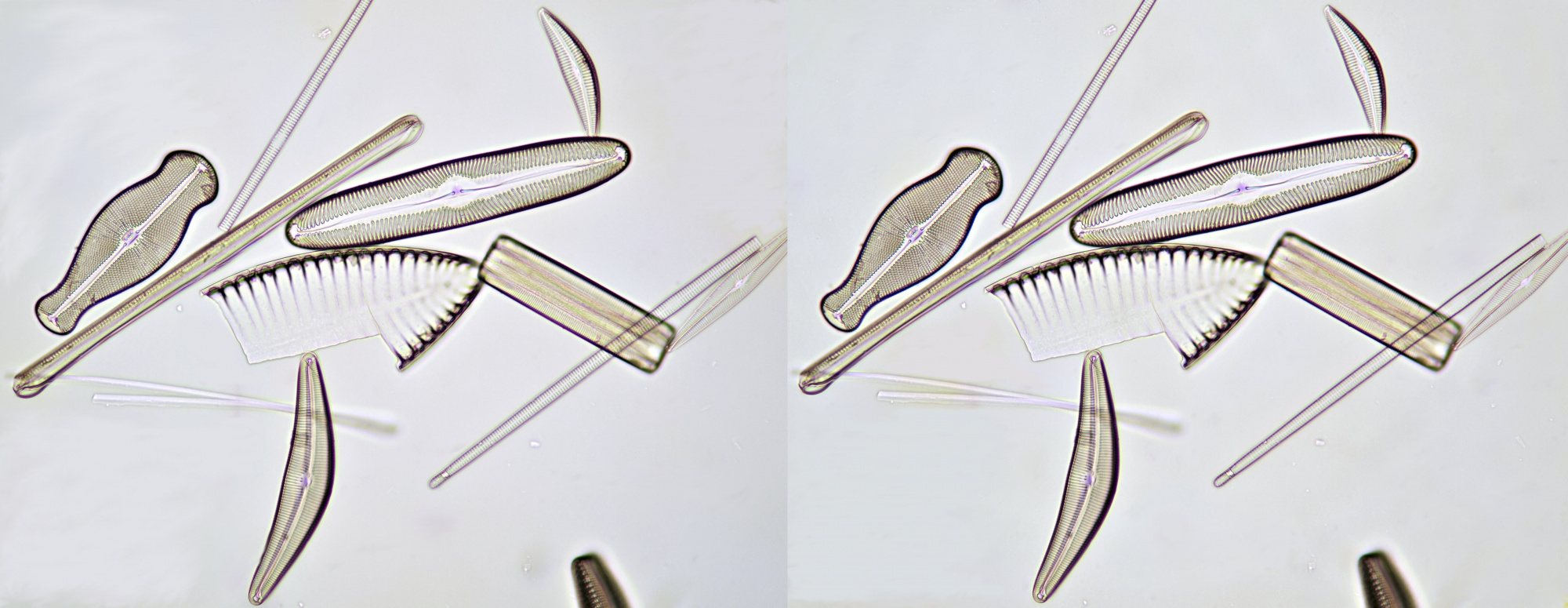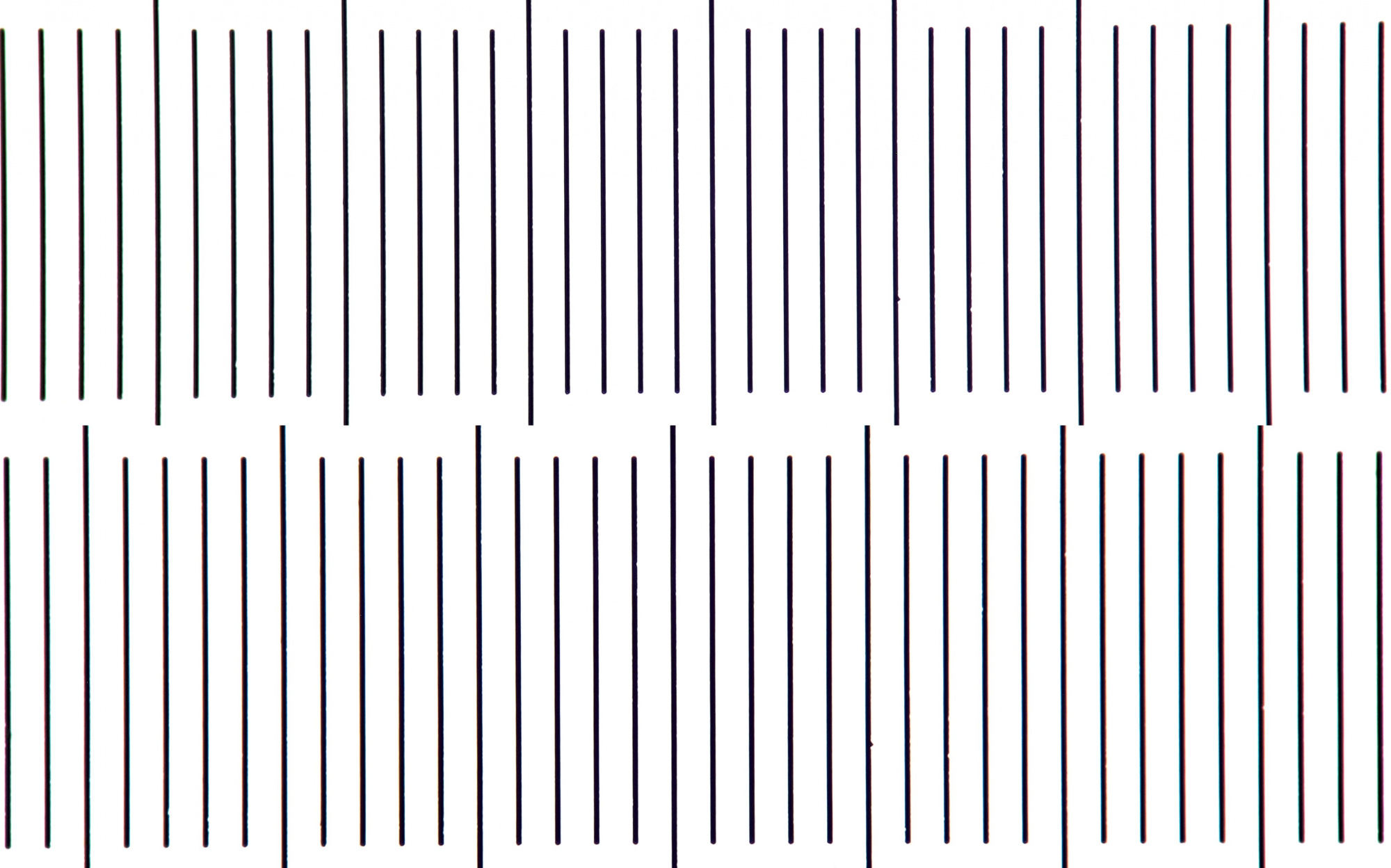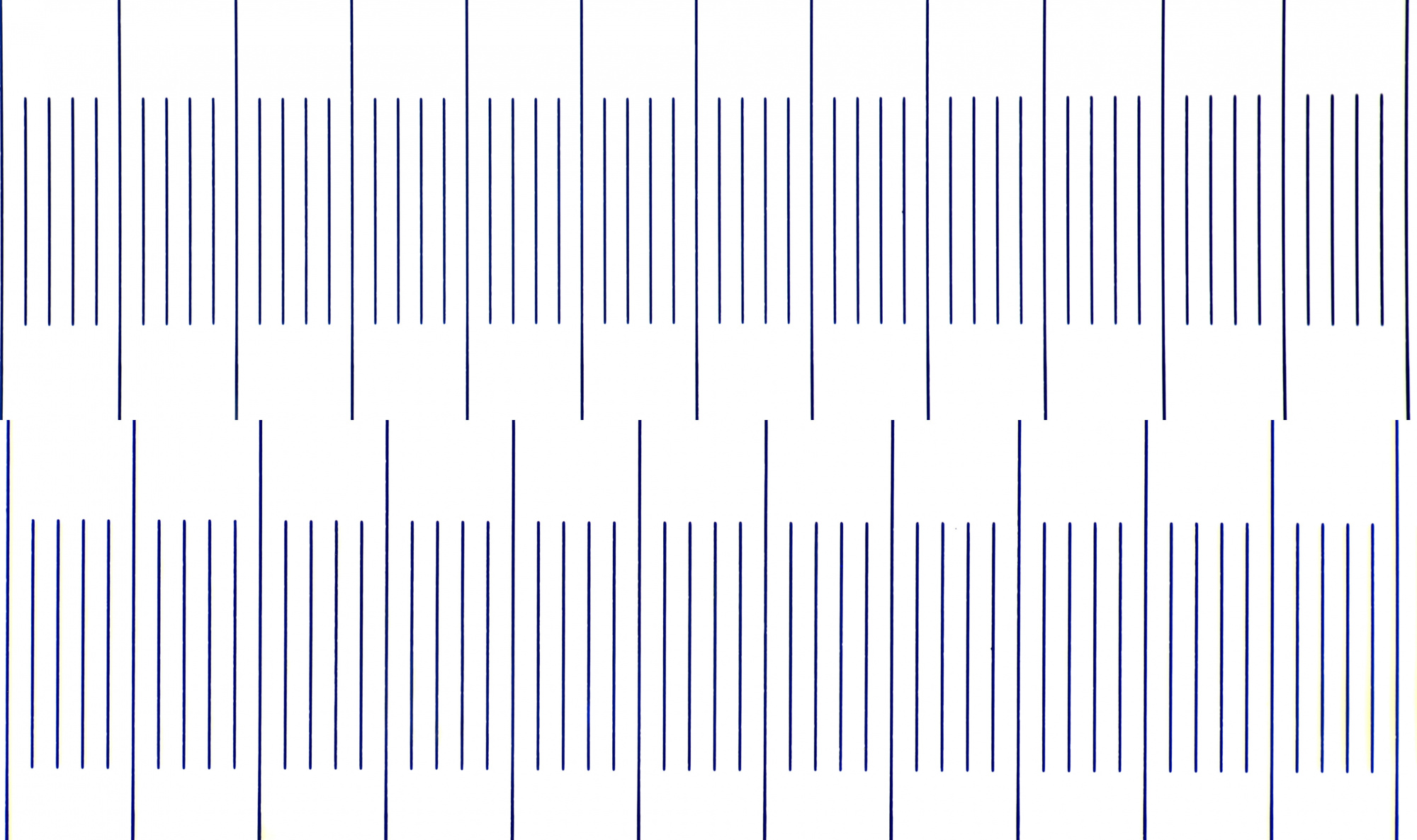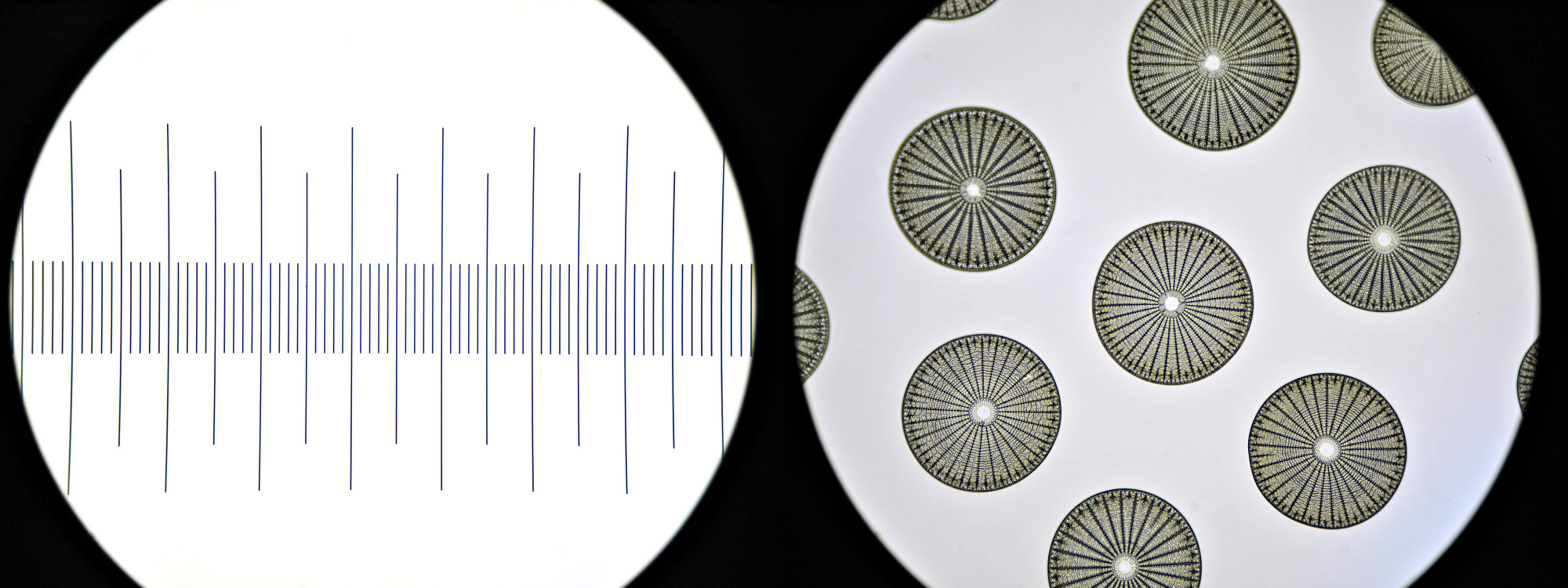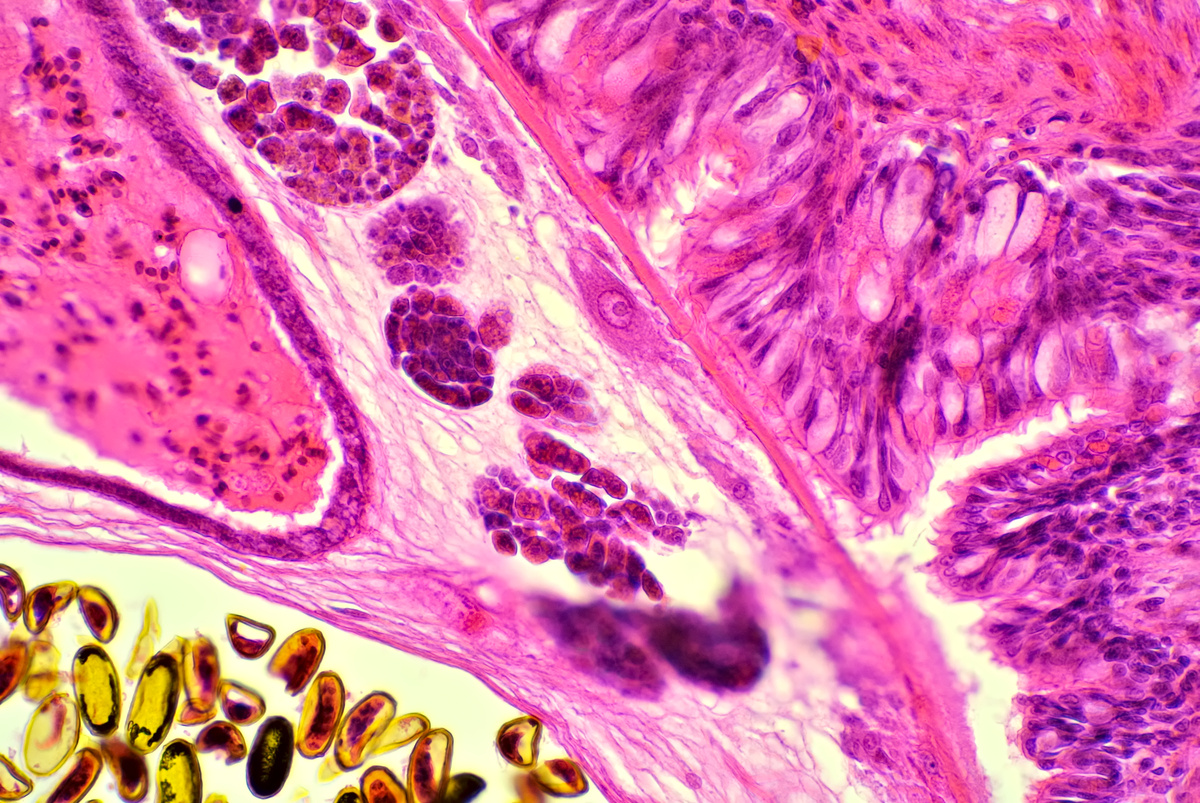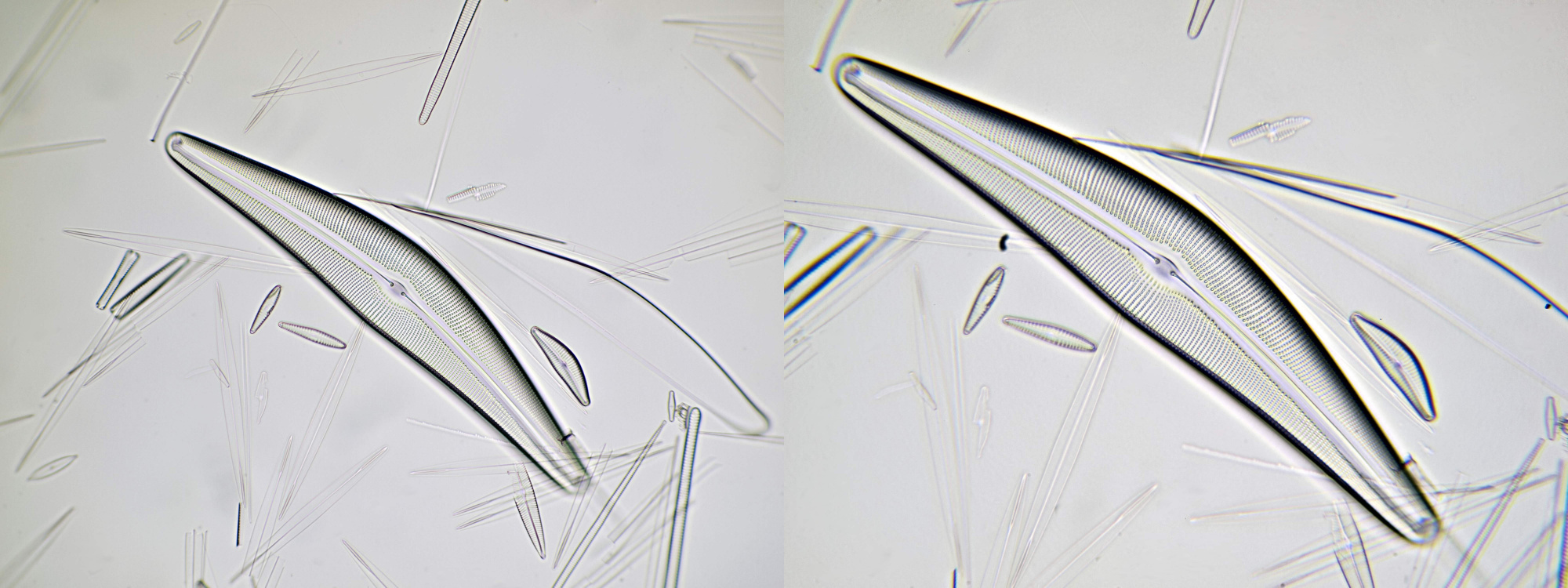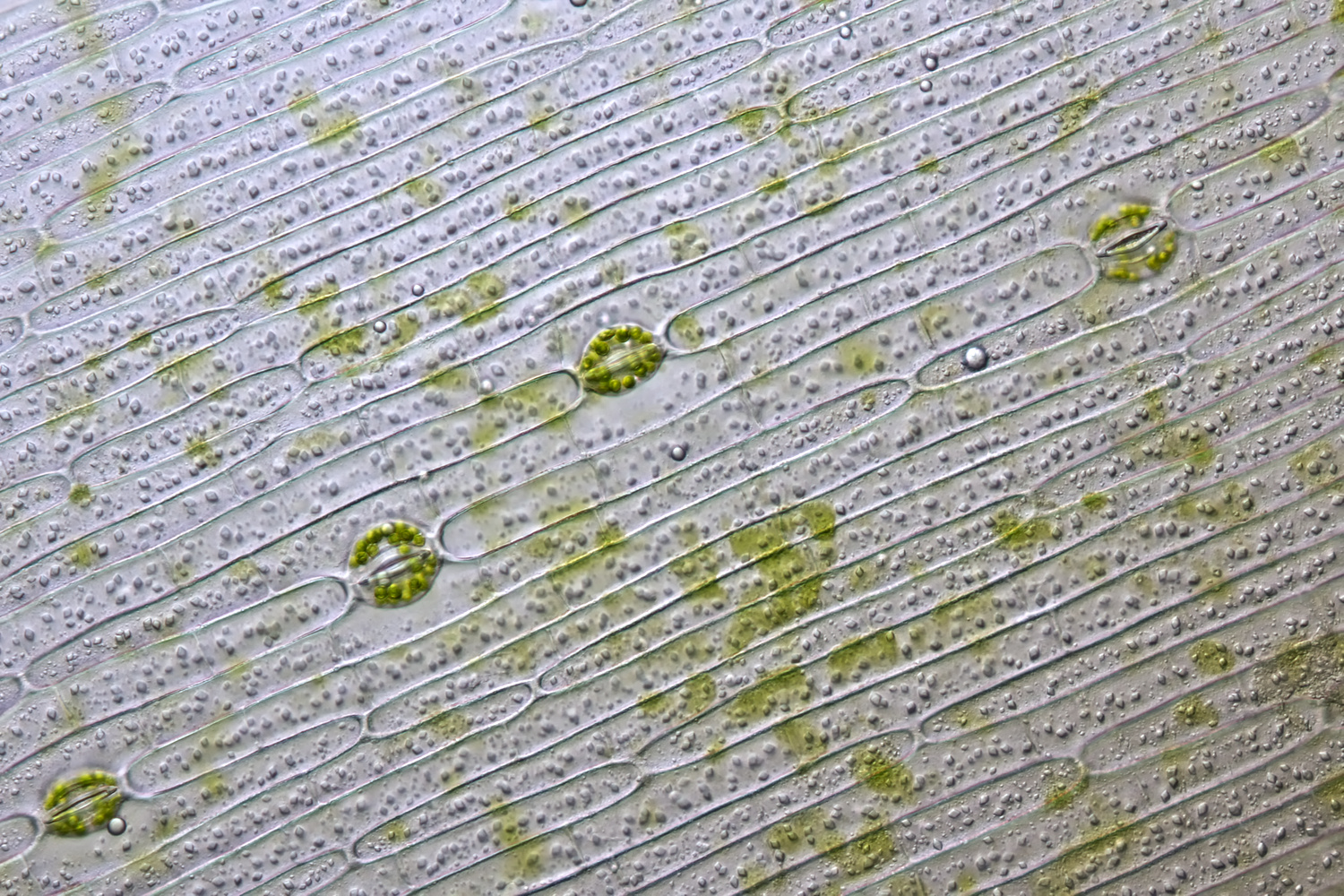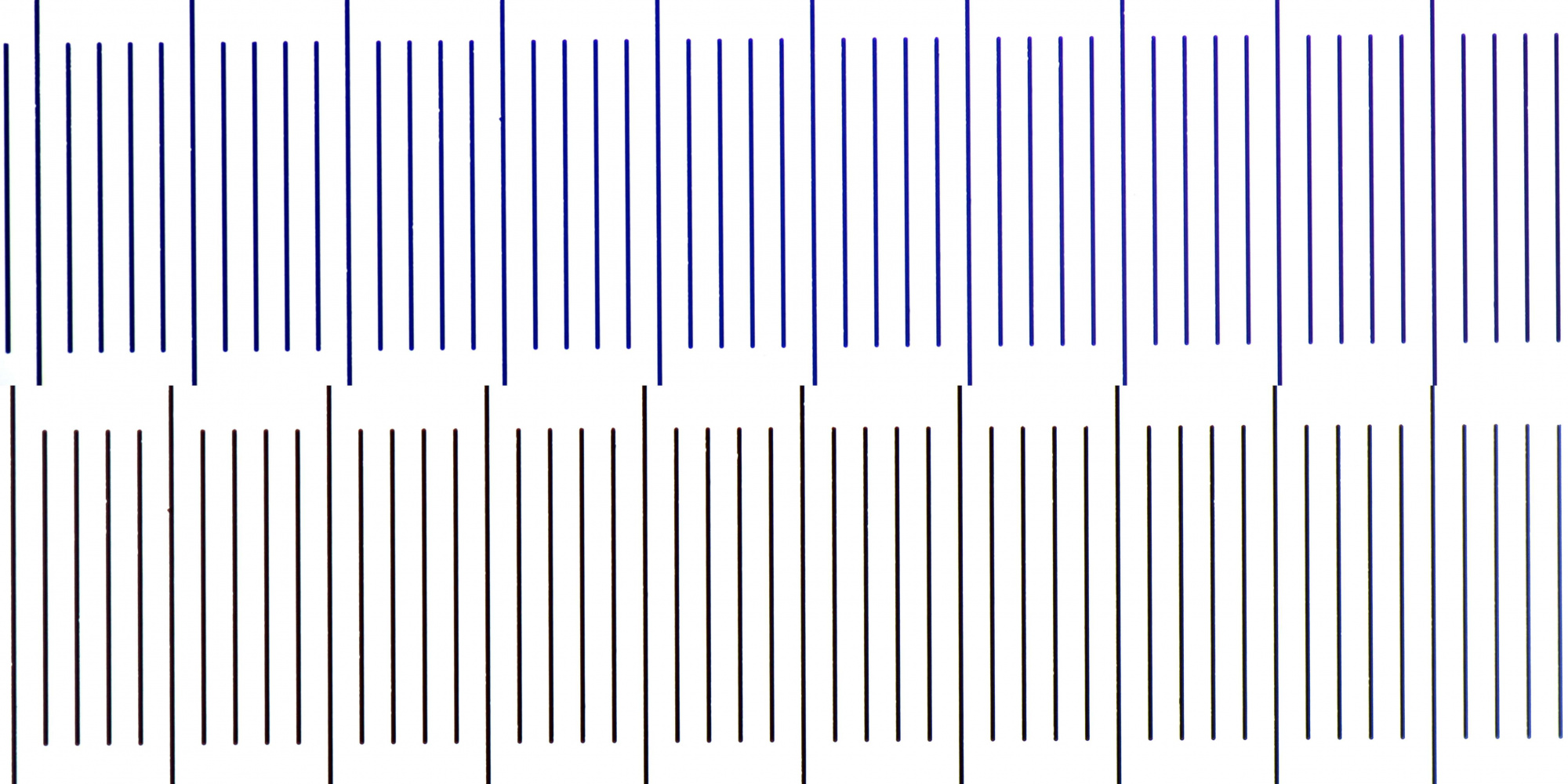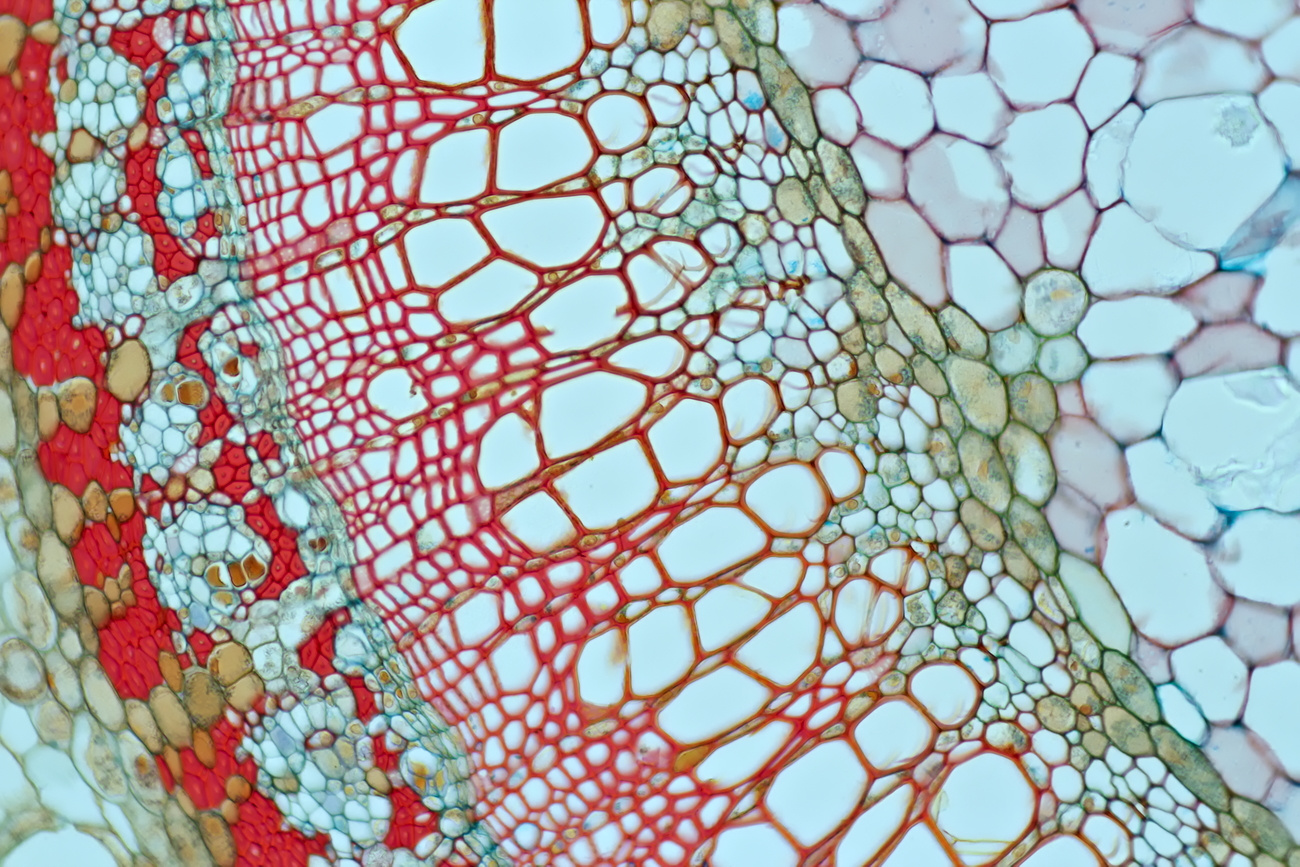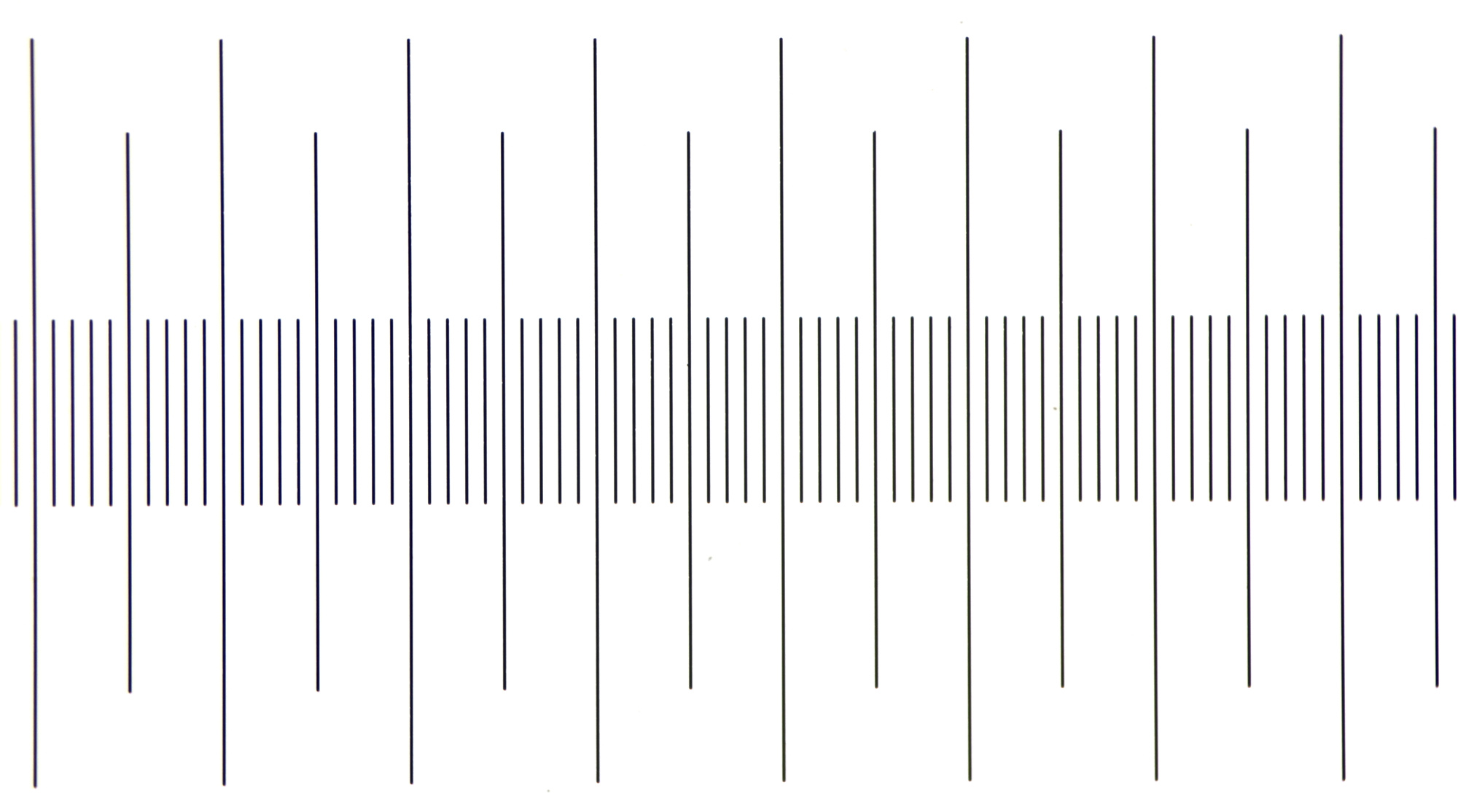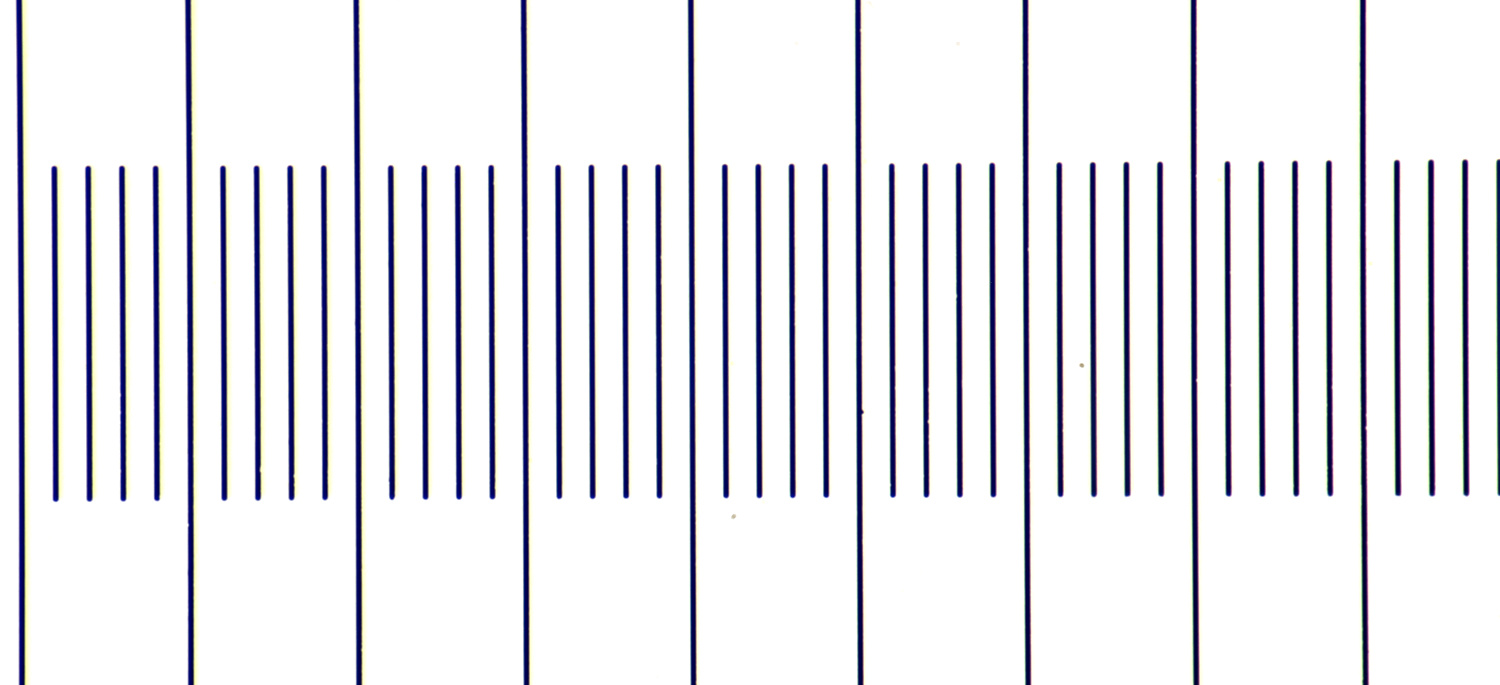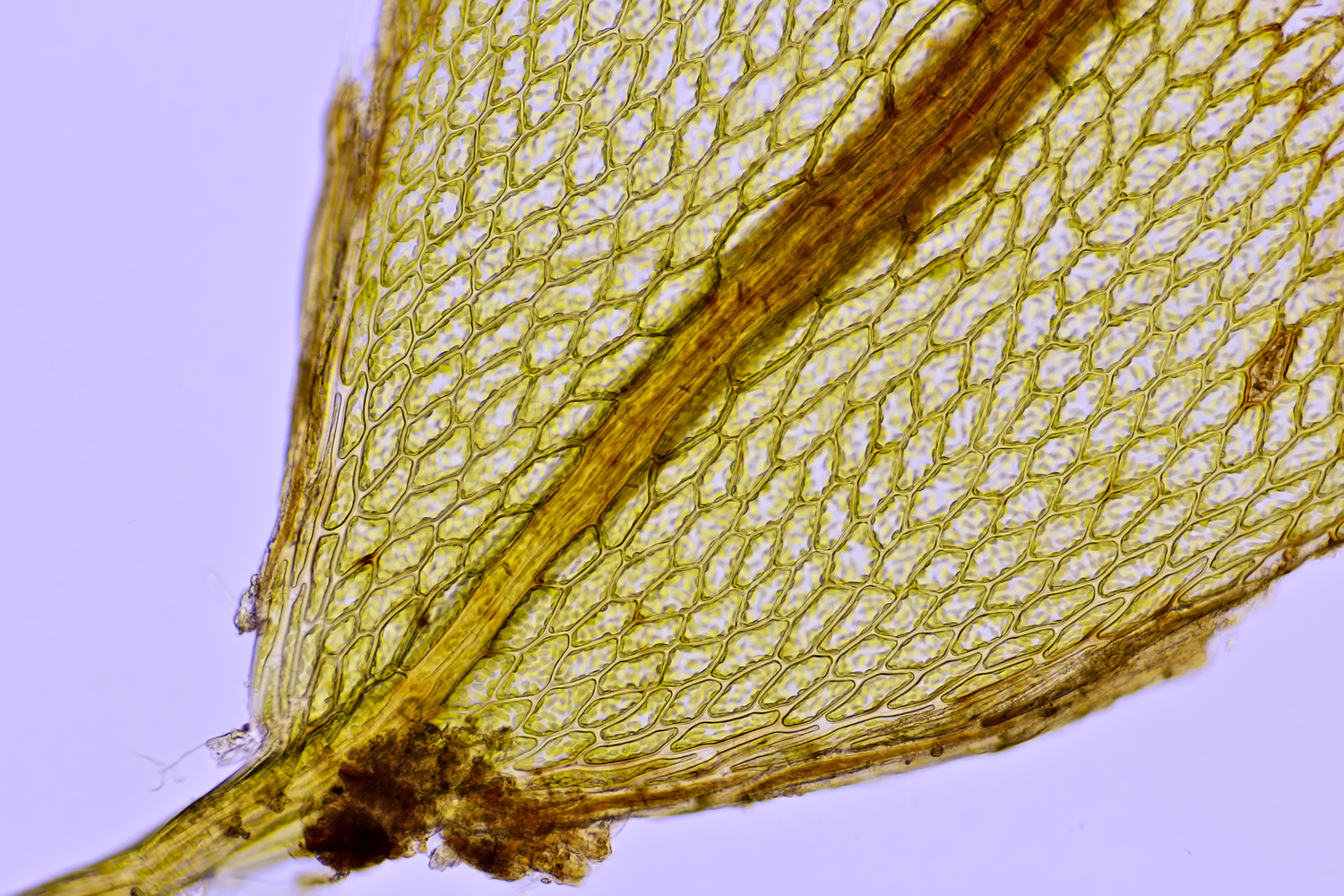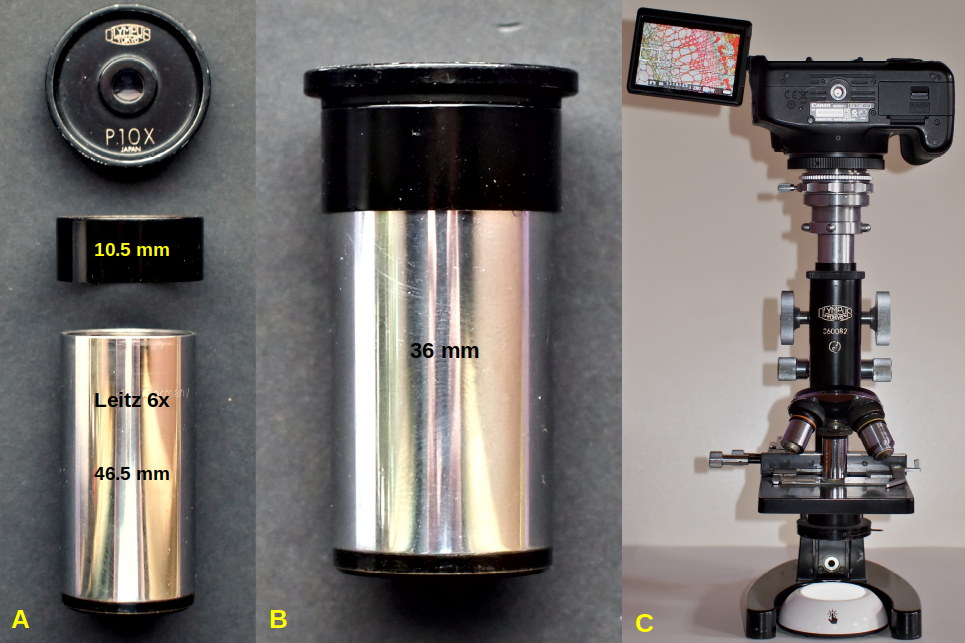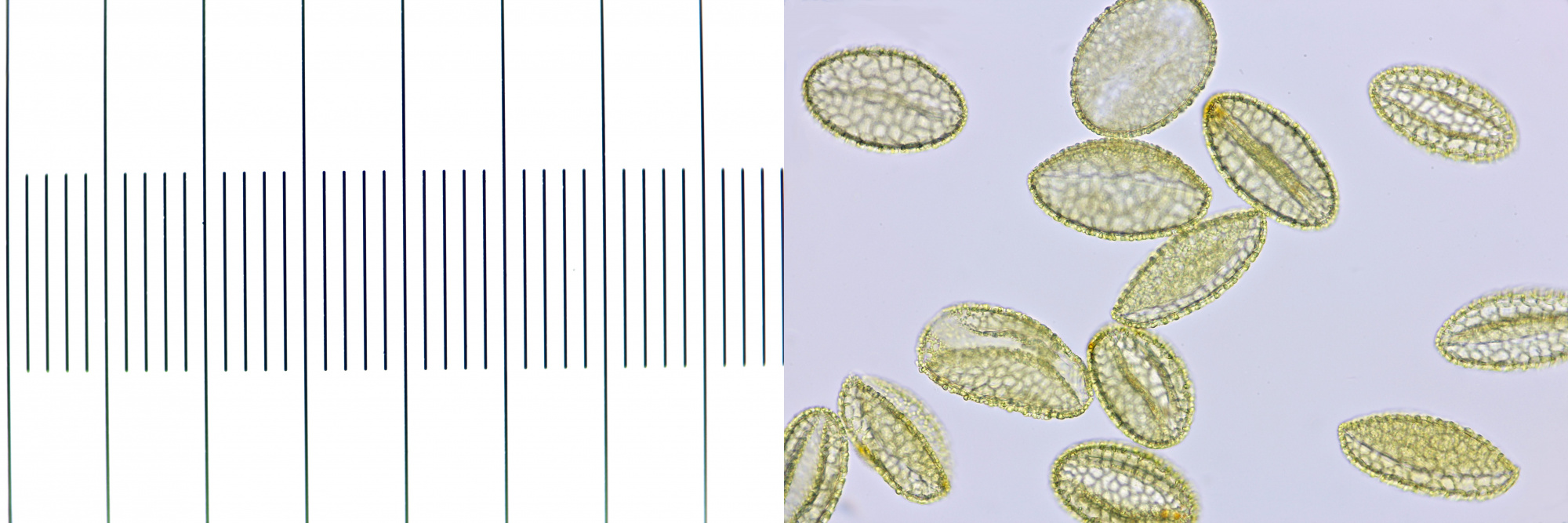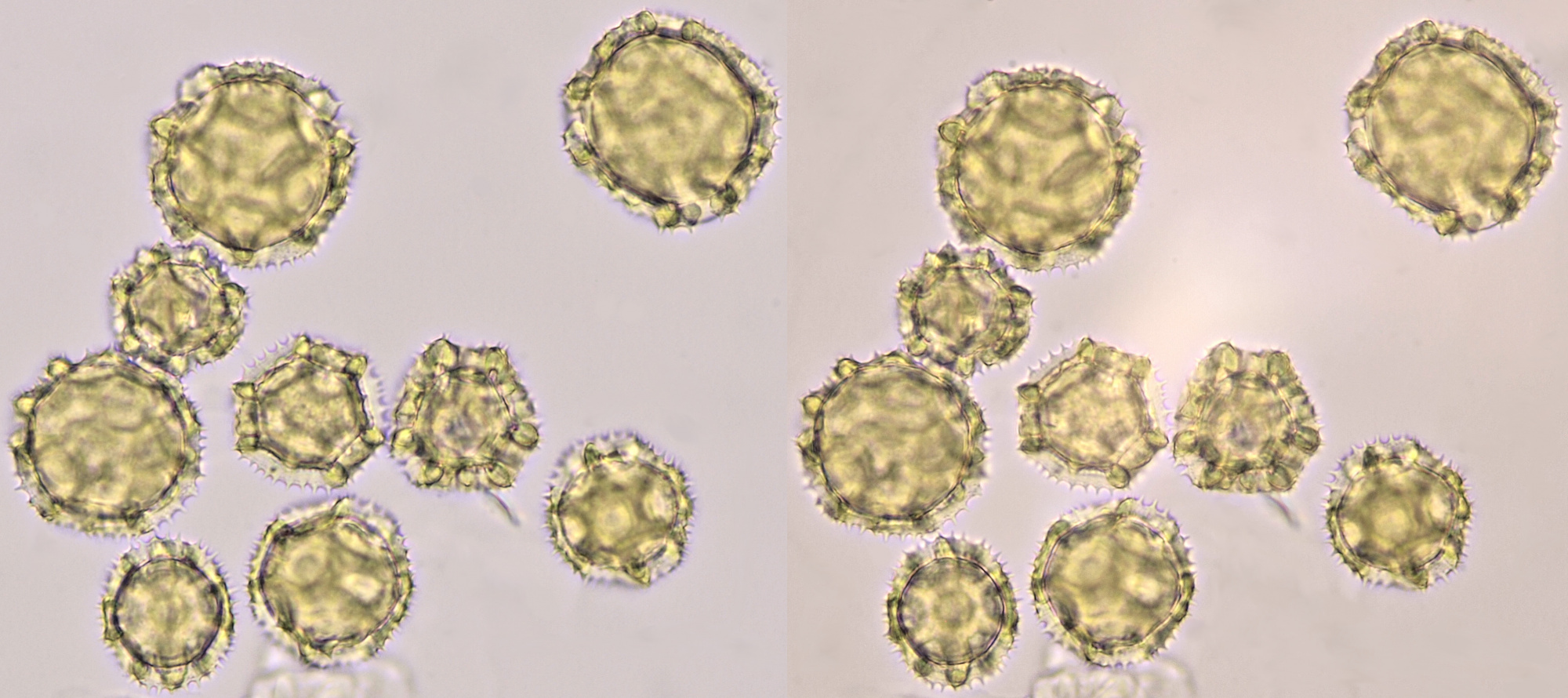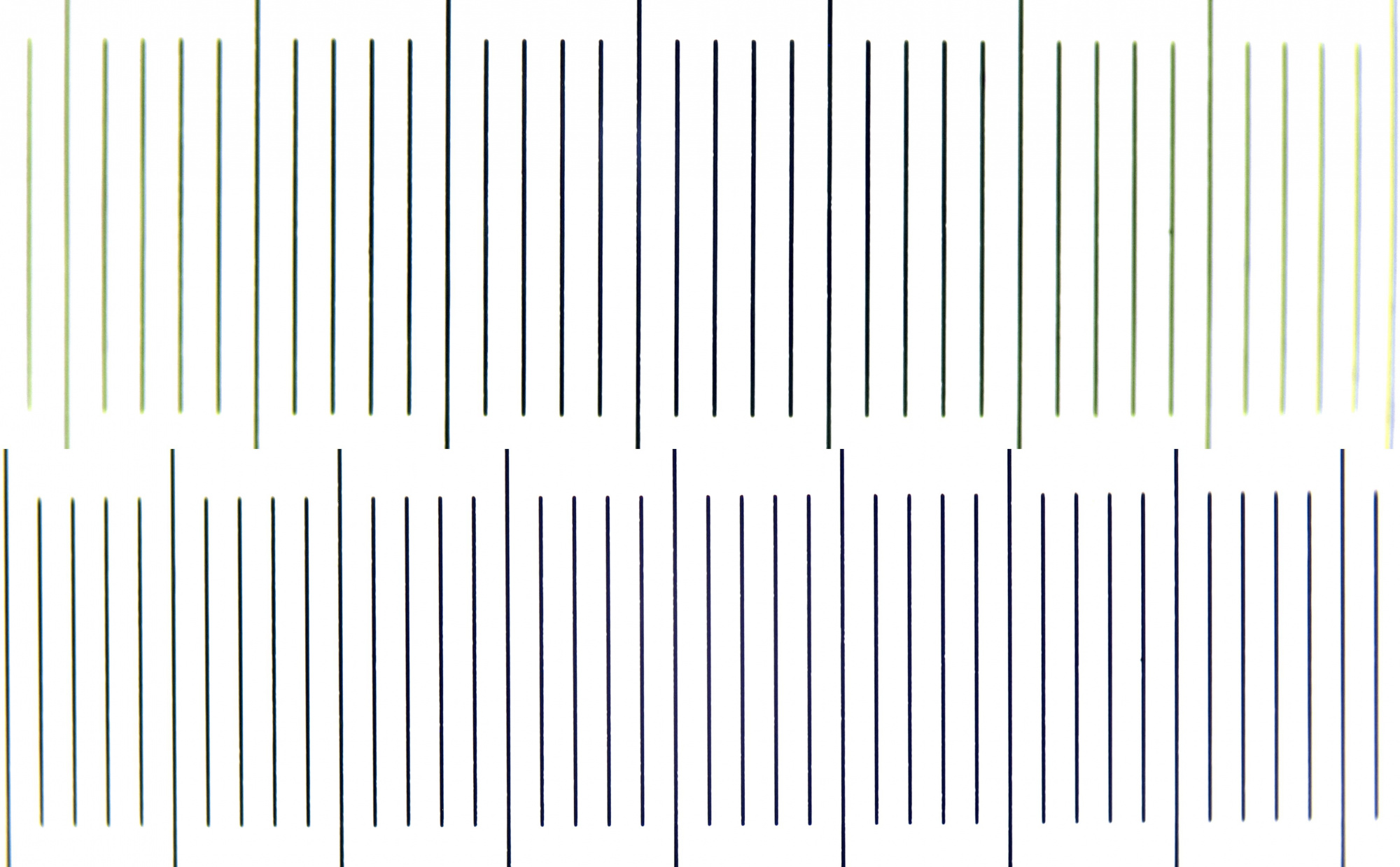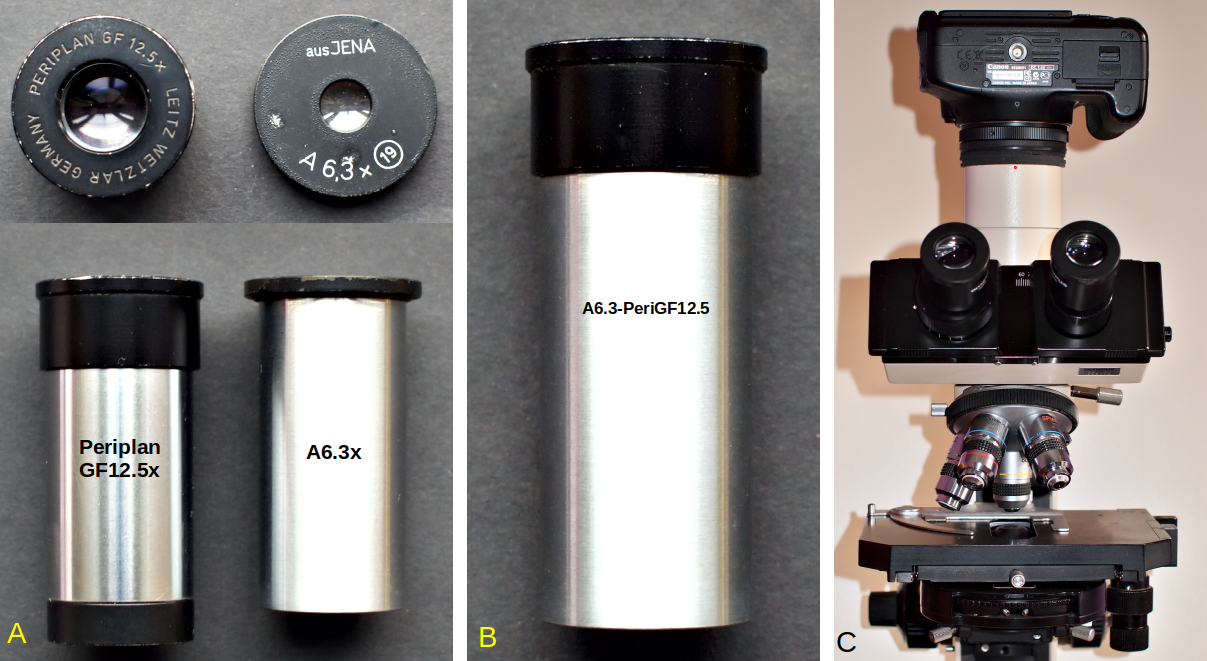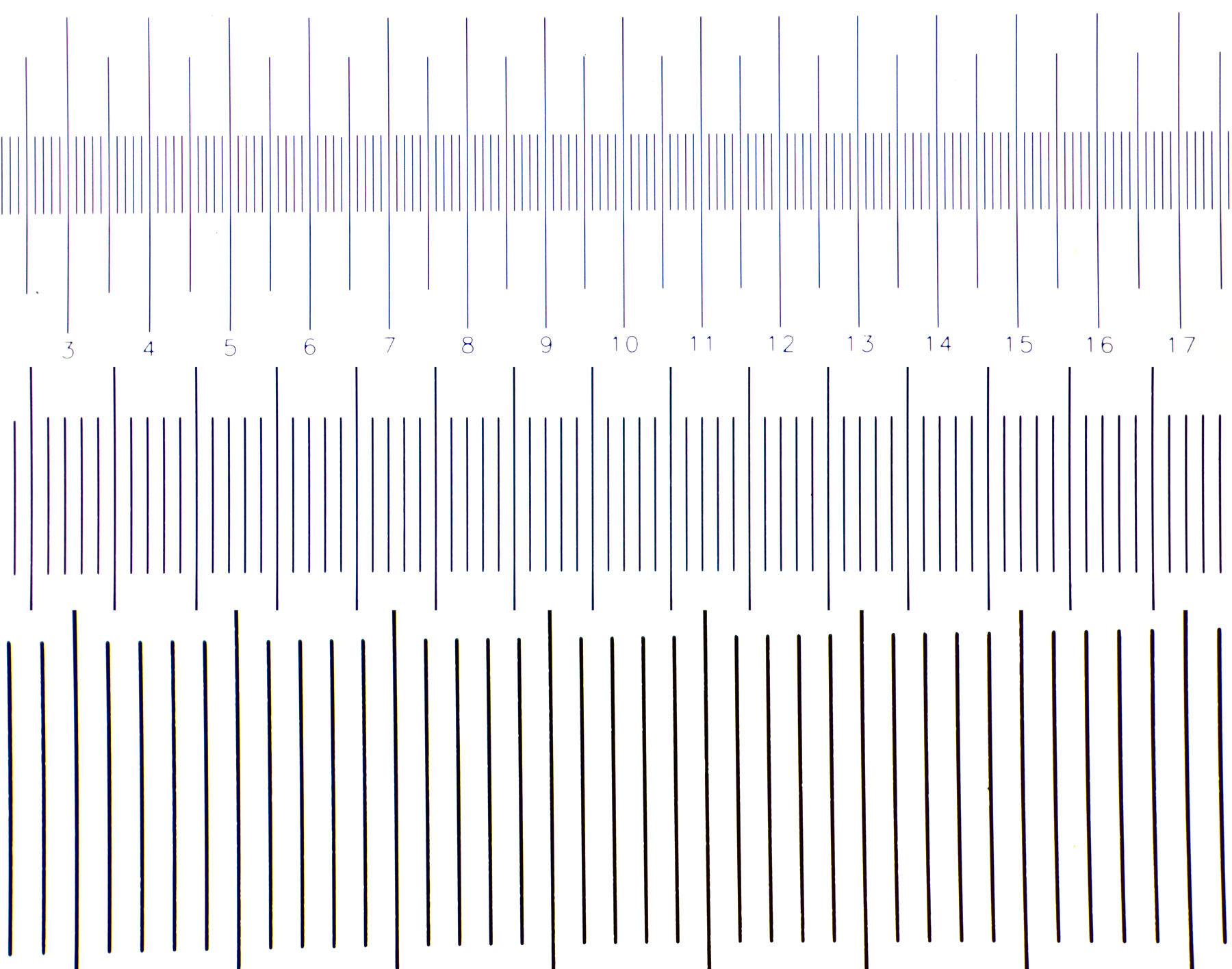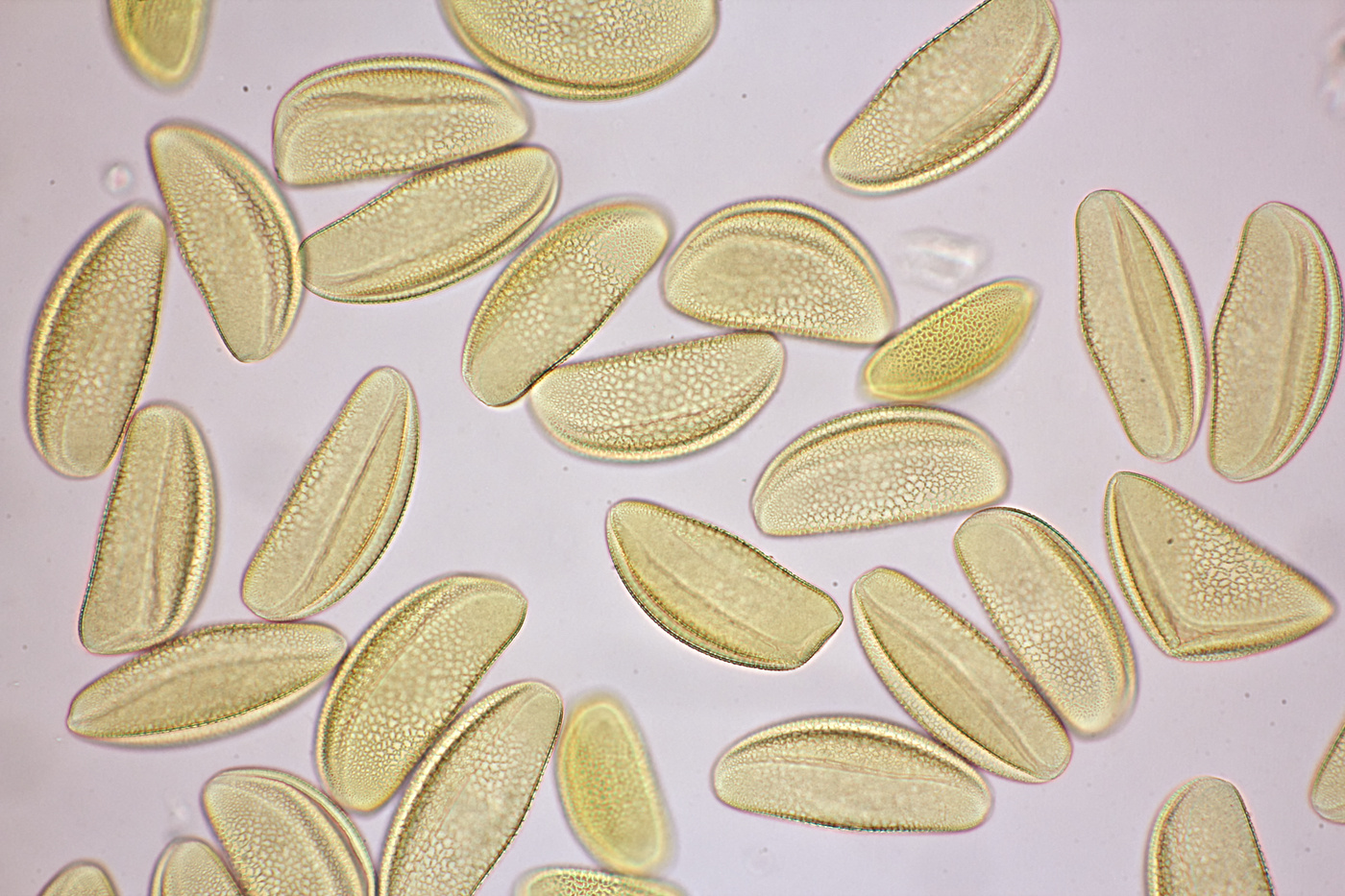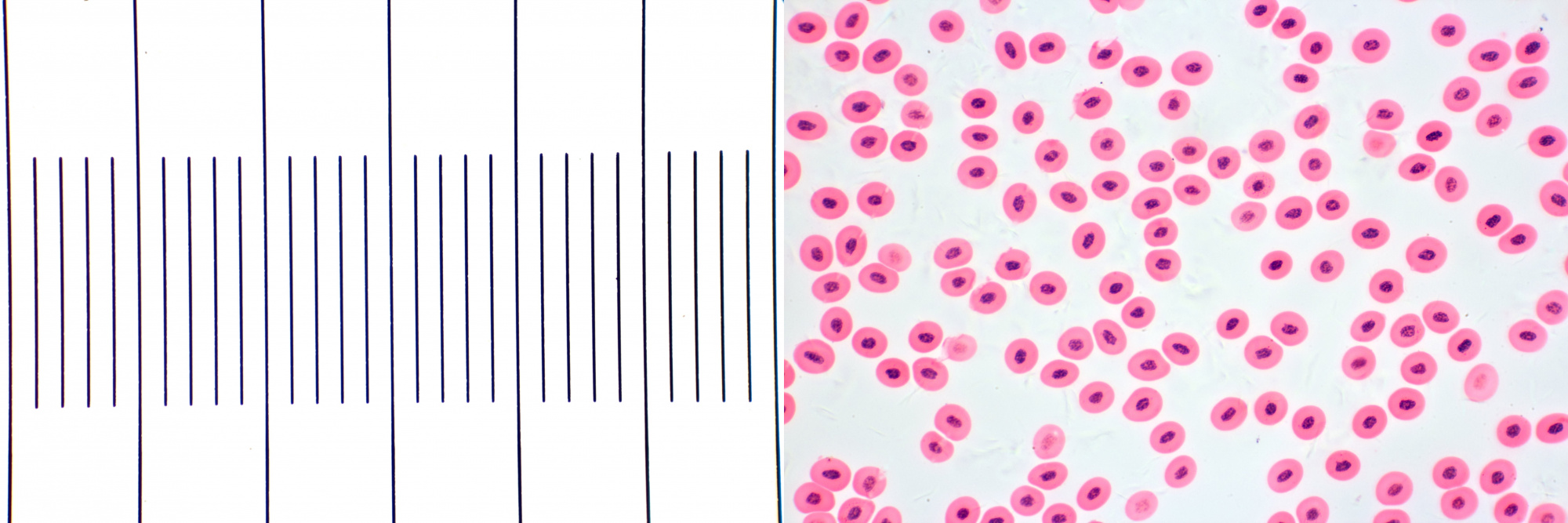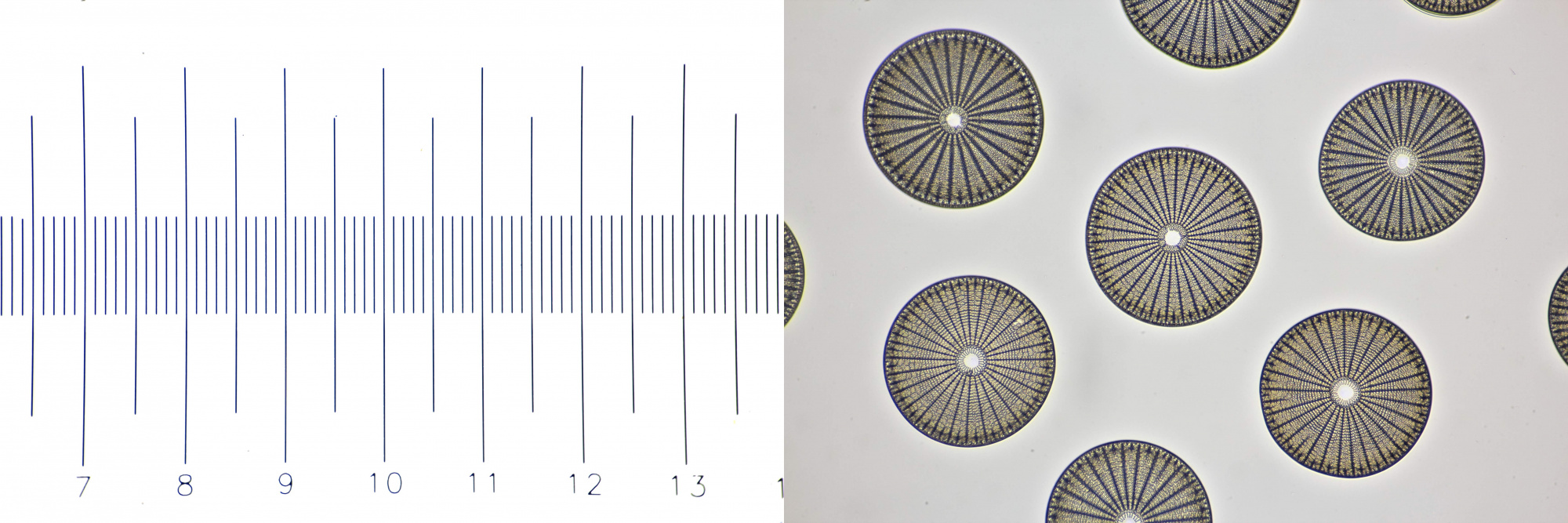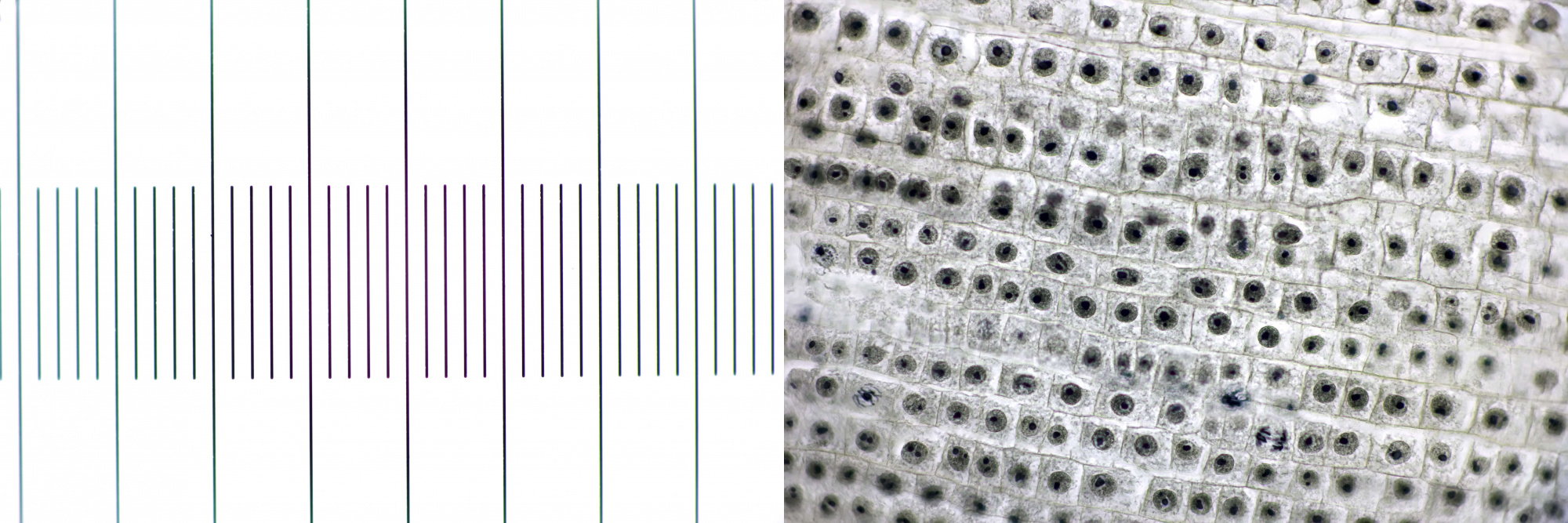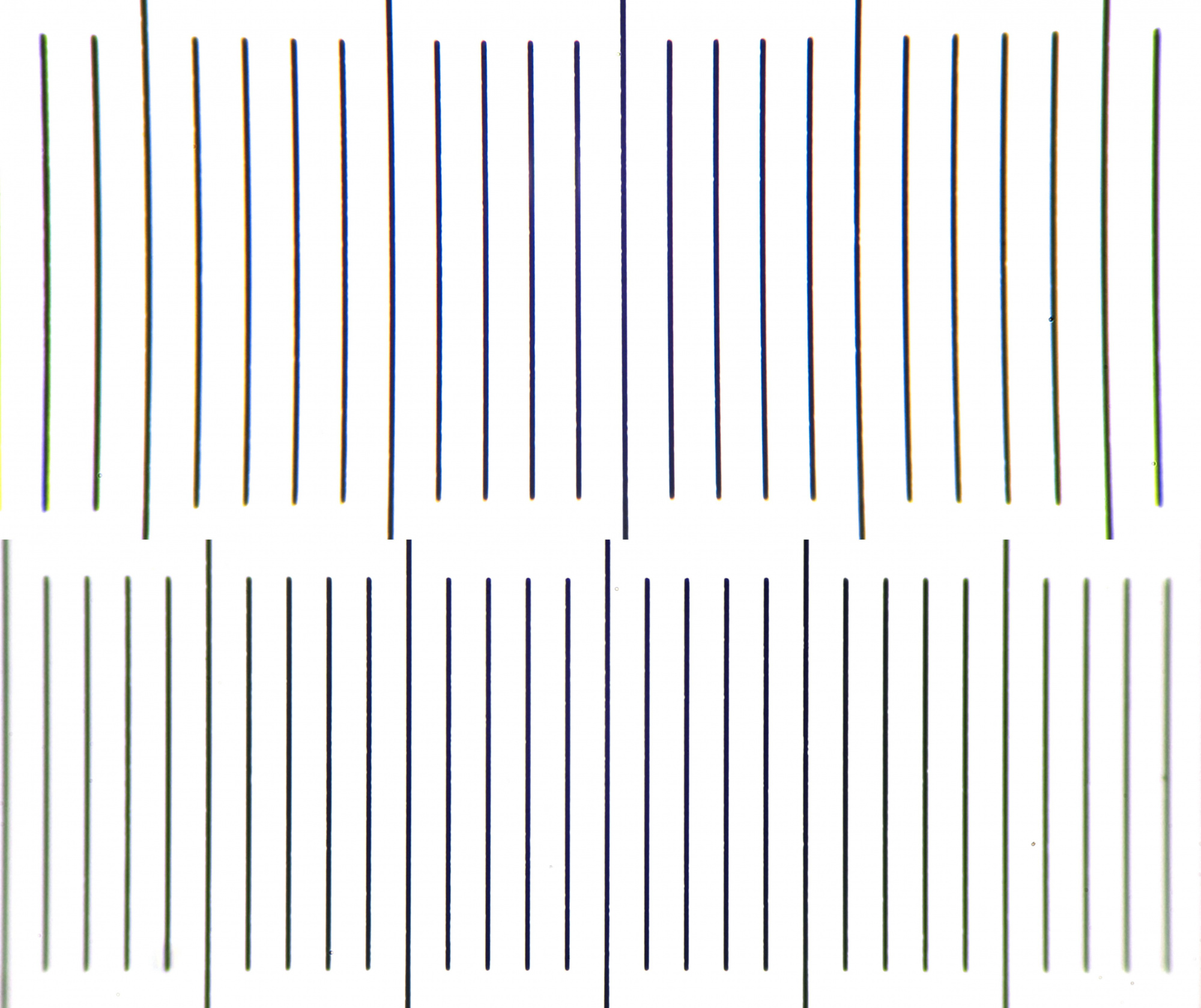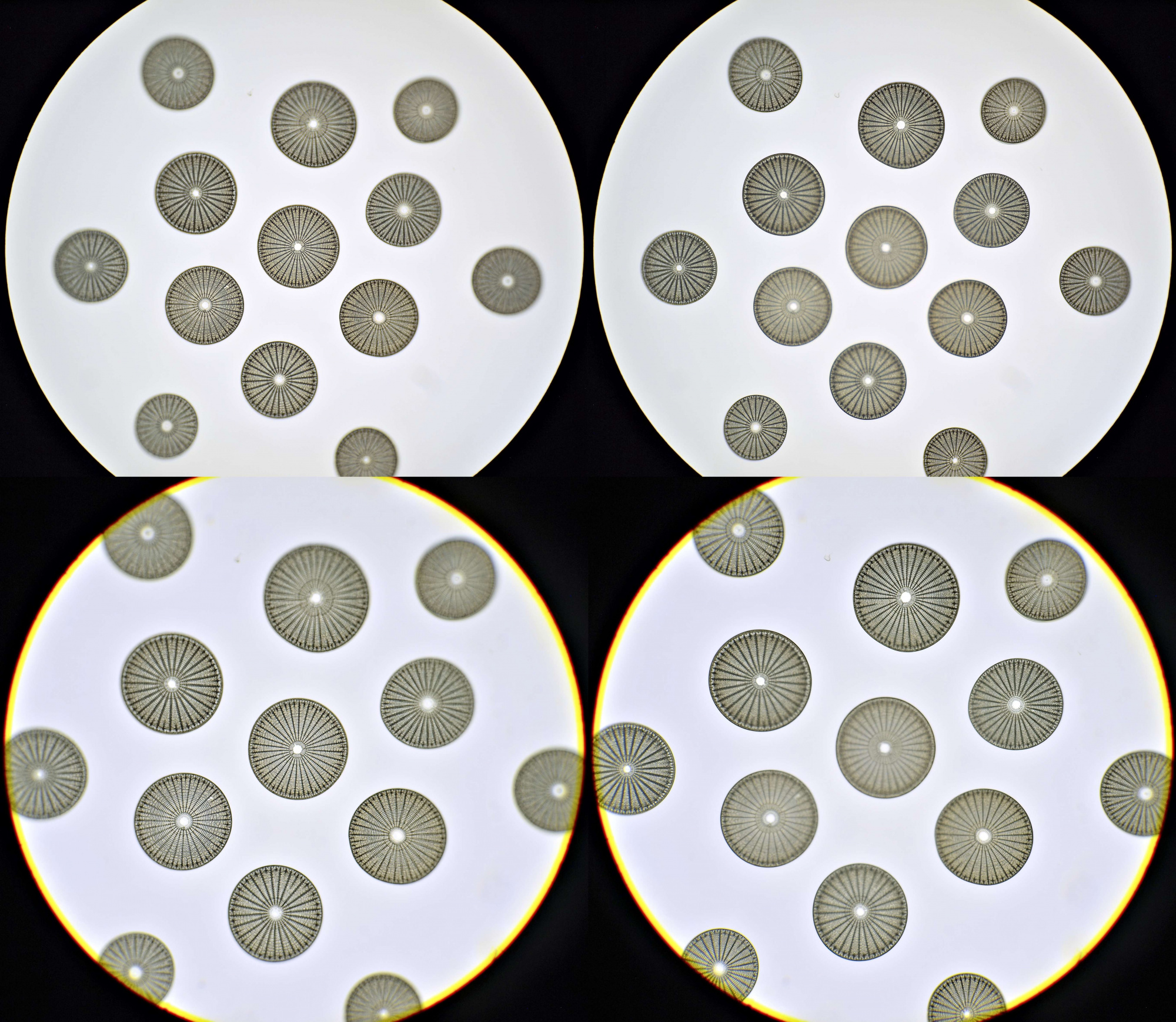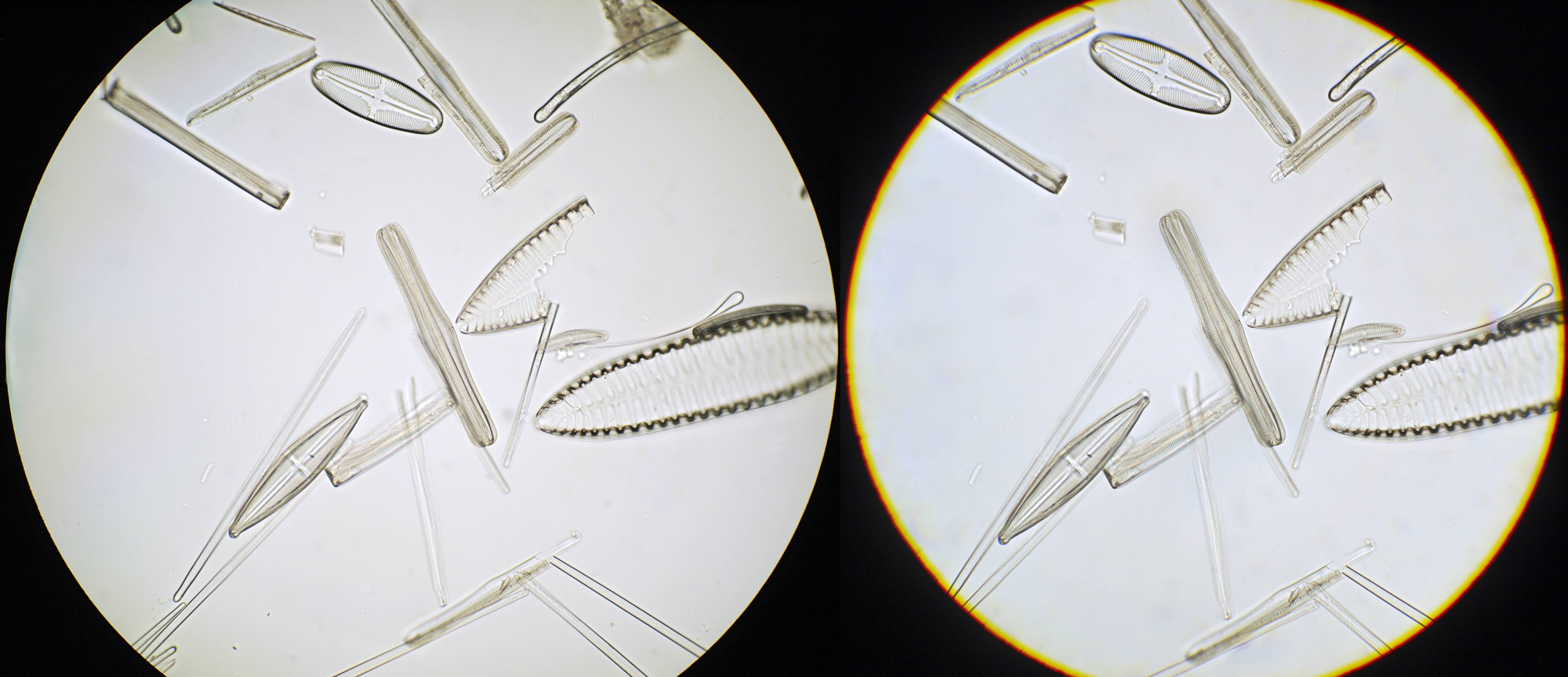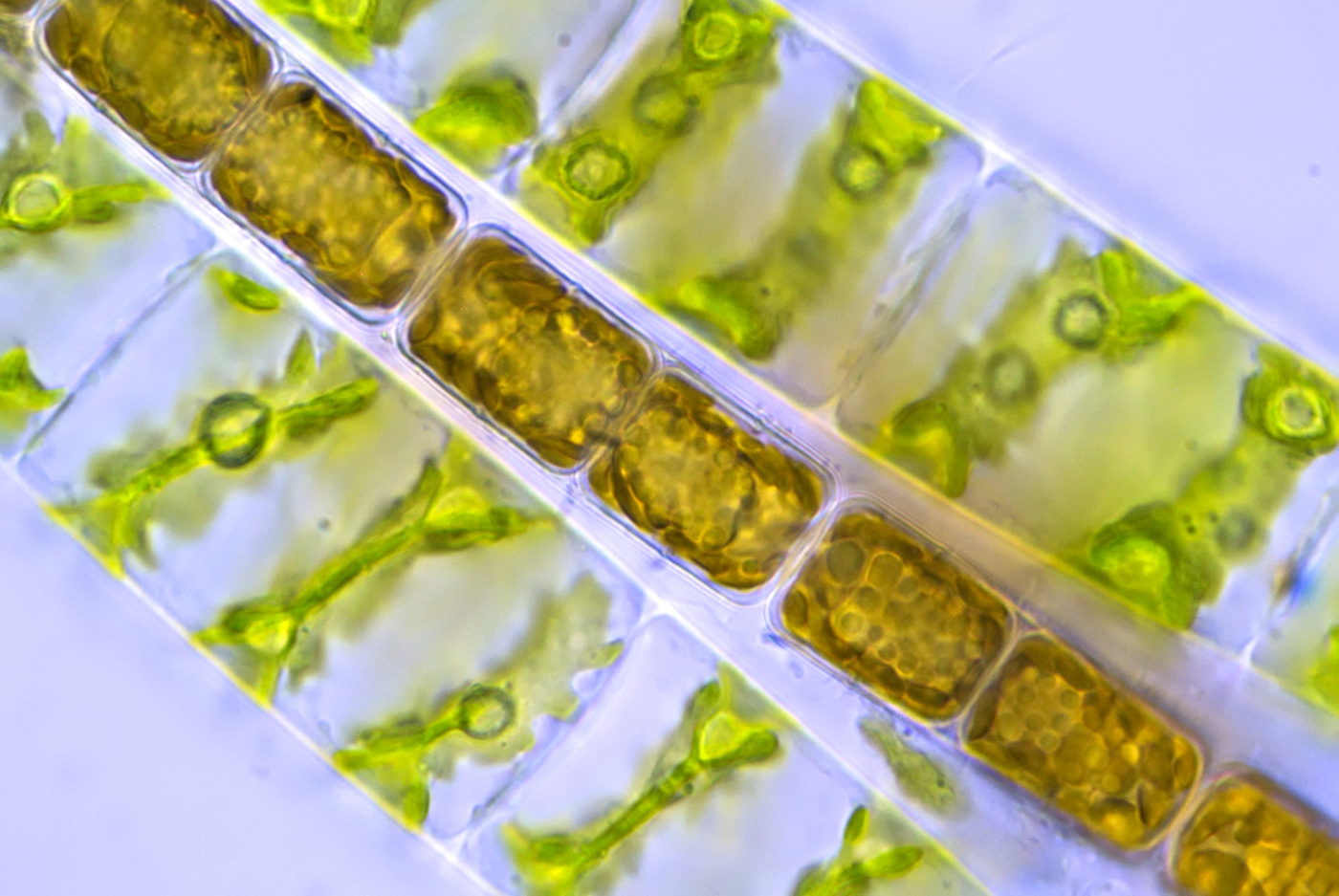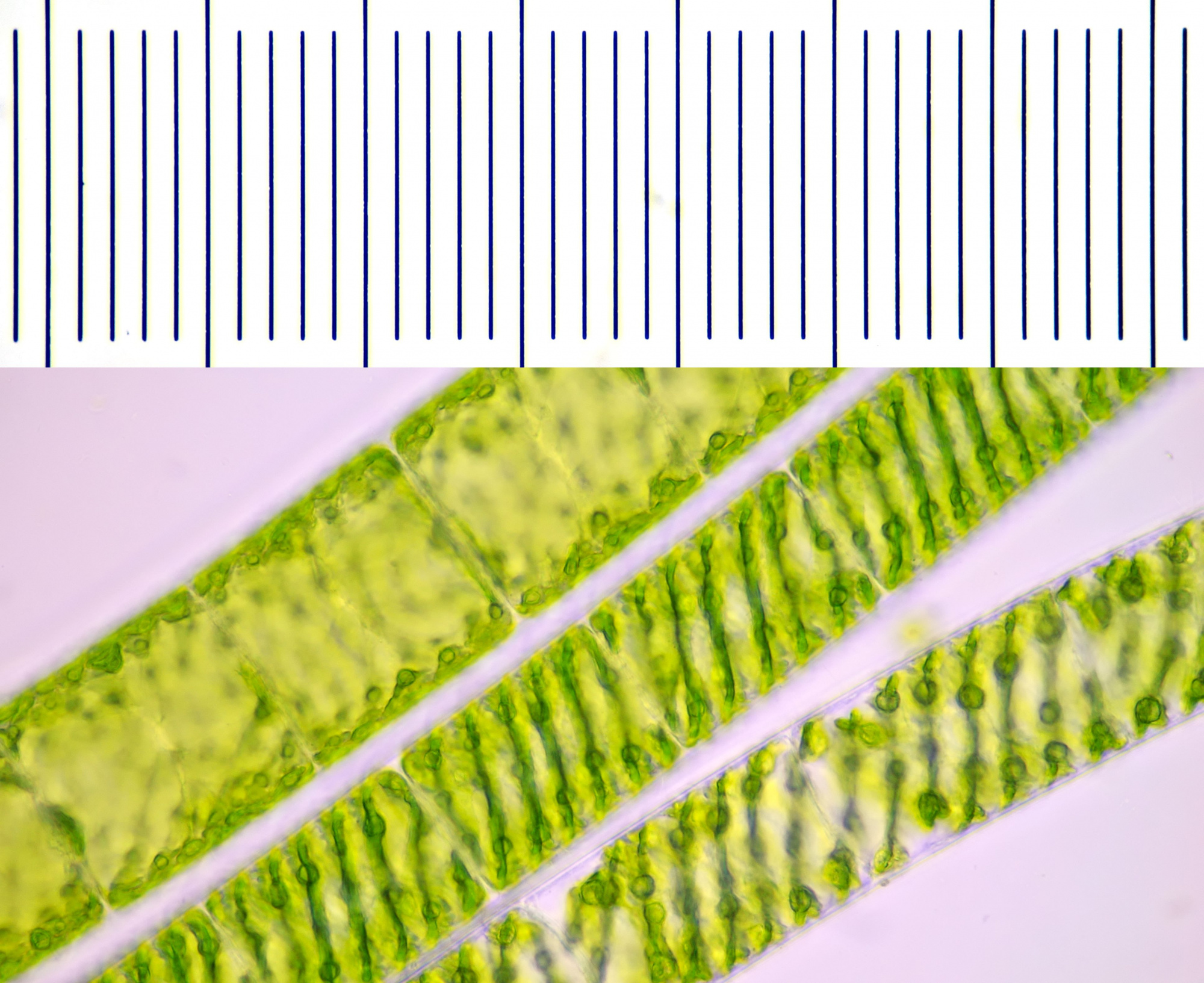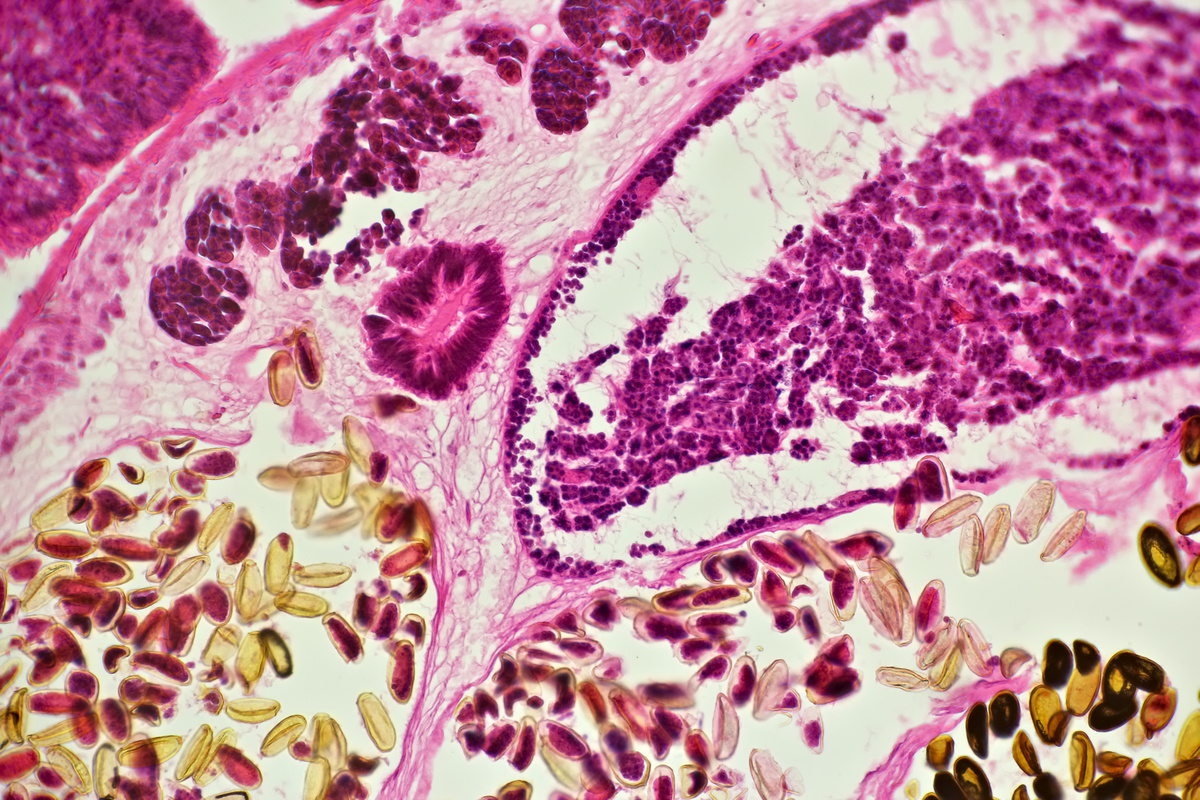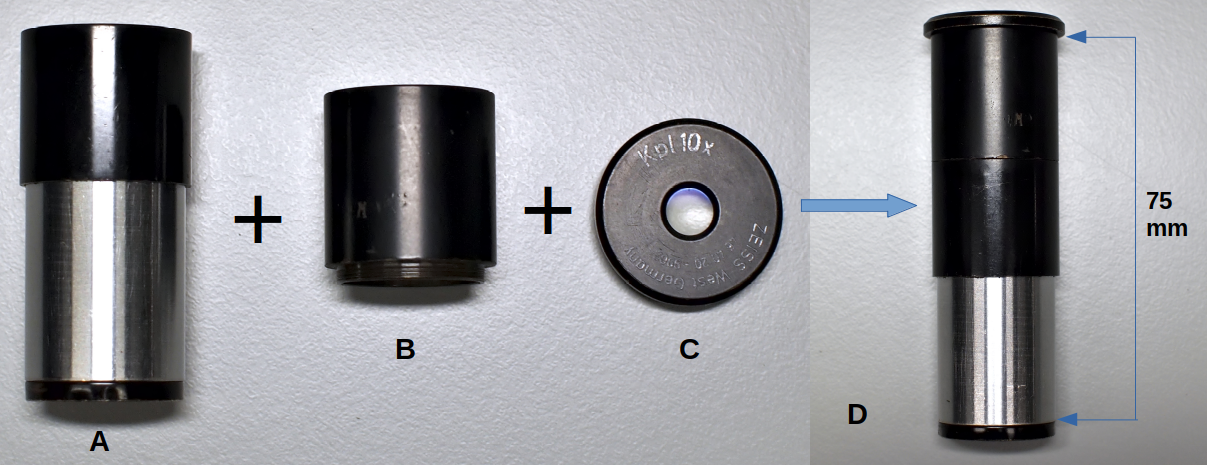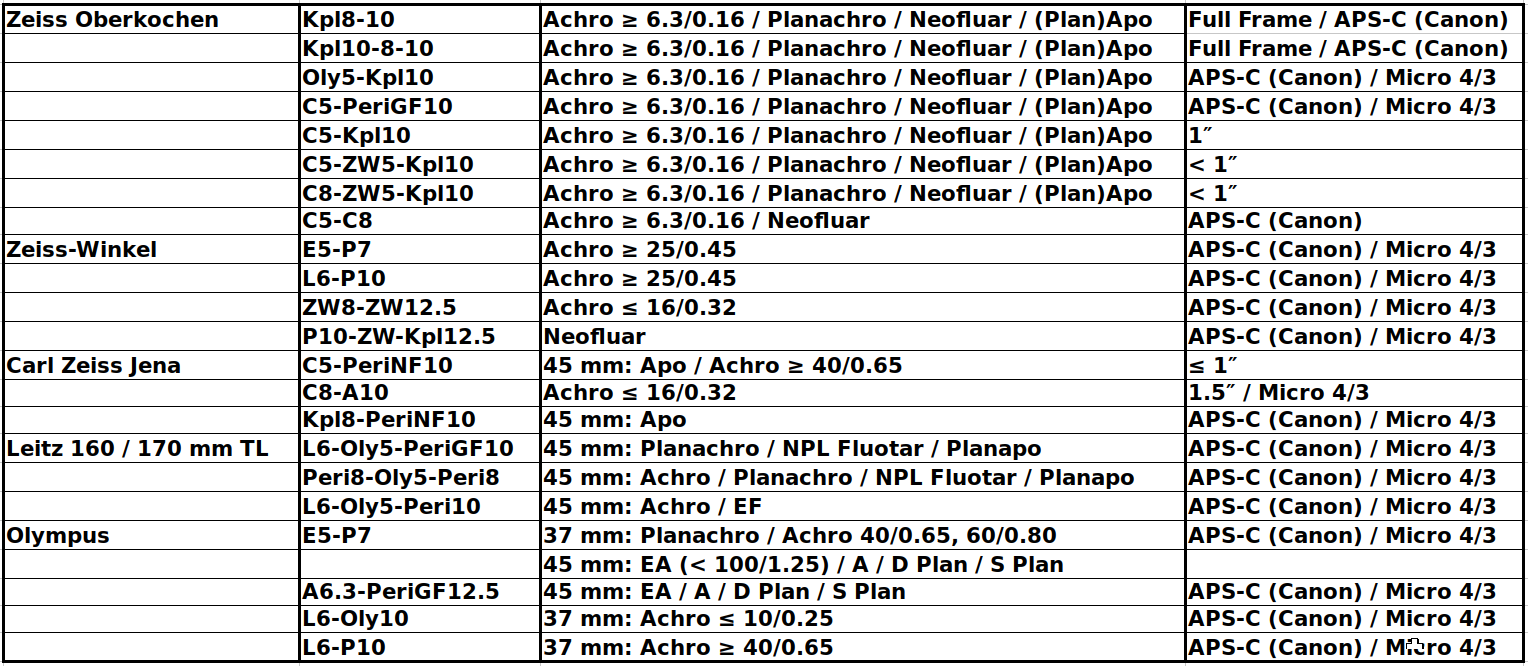Introduction
When using microscopes with finite optics (mostly 160 or 170 mm mechanical tube length) there are roughly two ways to perform microphotography:
1. Afocal method. With this method, there is a lens or camera objective between eyepiece and camera sensor. The camera lens acts as a relay optic and captures the image that is corrected by the eyepiece.
2. Projection by means of a special projective or photo-eyepiece. Here there is no (camera) lens between the eyepiece and sensor and the image is projected onto the sensor by the respective eyepiece or projective.
There is a third way, however, which I would like to leave out of consideration here and that is the direct projection of the image from the objective onto the sensor, without the use of an eyepiece.
For a long time I have used the afocal method, but after a lot of experimenting with eyepieces that can serve as projection eyepieces, I have become convinced that the latter method produces better images. With the afocal method, there is extra glass between the eyepiece and the sensor. It is certain that this will never improve the image in the center of the microscope field. Any additional optical element in the optical path can potentially degrade the image. And on any additional glass surface, disturbing dust speckles can settle.
Projectives are special eyepieces that correct the image formed by the objective and project it onto the sensor. For photography with DSLR cameras, projectives with low magnifications are particularly suitable. A highly wanted projective is for example the NFK 1.67x, to be used with the Olympus BH2 microscope system. However, the price for this projective on the second-hand market is often absurd.
Not all microscope manufacturers have produced useful projectives in the past. Carl Zeiss, for example, went the afocal path at one point and because of this, photography with Zeiss microscopes with 160 mm mechanical tubelenght was and is mainly done with a relay lens between eyepiece and sensor. If you want to photograph with for example a Zeiss Standard microscope without any relay optics, an ordinary observation eyepiece (e.g. a Kpl10x) can be used as a projective when the position of this eyepiece in the photo tube is raised a few mm. However, the results with this are variable and there is often a clear chromatic aberration at the edges of the image when photography is done this way.
Hybrid eyepieces
I own a fairly large collection of eyepieces and at one point I wondered what would happen if I would combine two different Zeiss eyepieces and used them as a projection eyepiece for photography. So, I exchanged the eye lens of a Zeiss Kpl8x eyepiece with the eye lens of a Kpl10x eyepiece. I had only expected a bad image, but the result was surprising. Not only did the image on the camera appear parfocal with the visual image, there was also very little chromatic aberration at the edges. The result was significantly better than when using a raised Kpl10x eyepiece. The fact that it works better this way than raising a normal eyepiece is probably caused by the increased distance between field lens and eye lens. Apparantly, the eyepiece is functioning like a projection-eyepiece this way. With some photo-eyepieces, like for example the Carl Zeiss FK10x, it's also possible to vary the distance between the two lenses. In any case, the chromatic aberration is largely canceled. I also experimented with Leitz and Olympus eyepieces. I have called these mixed eyepieces 'hybrid eyepieces'. Some results are shown below.
Parfocality, mechanical tube length and experimental considerations
The correct distance between the eye lens of the hybrid eyepiece and the camera sensor is the distance were complete parfocality is reached. If you want to experiment with this method, it is therefore recommended to use a camera-adapter with which the distance between camera sensor and eyepiece can be varied. The correct distance can be determined quickly and easily:
1. Place a normal eyepiece in the photo tube and focus on a slide visually.
2. Place the hybrid eyepiece in the photo tube and attach the camera.
3. Now, adjust the distance between camera and eyepiece so that the image appears sharp on the camera display.
While testing, I often used horseshoe stands because these are the least complex microscopes and the mechanical tube length is easy to measure. A horseshoe stand is in fact nothing more than a photo tube without any internal optics and where the correct mechanical tube length and good centering are guaranteed. The more complex a system, the more likely errors will occur, for example because there are all kinds of extra optical elements in the optical path that produce unexpected results. This may also cause deviations in the intended mechanical tube length. The mechanical tube length is the distance between the nosepiece opening, where the objective is screwed in, and the top of the edge of the tube where the eyepiece is inserted. With Zeiss Standard microscopes I found out that different trinocular heads exist where the height of the photo tube can differ. This has a direct effect on the results. If in doubt, it is a good idea to measure the distance between the nosepiece opening and the top of the (photo) tube with a ruler. Furthermore, with Zeiss Standard, one must pay close attention that the system is properly centered: sometimes the photo tube or trinoculair head is seated de-centered on the stand because the screws are screwed in too deeply, which can then lead to single-sided chromatic aberration, i.e. on one side of the image. It is good practice to perform the tests with different microscopes, if one has them.
Zeiss
Hybrid eyepiece Kpl10-8-10: field lens Kpl10x - barrel Kpl8x - eye lens Kpl10x
I tested the combination of Kpl8x and Kpl10x eyepieces with a stage micrometer on a number of different Zeiss objectives. I started with just screwing the Kpl10x eye lens onto a Kpl8x eyepiece. This combination works well and parfocality is achieved. The combination of both lenses of a Kpl10x eyepiece screwed onto a Kpl8x barrel gives the most satisfactory results and a slightly larger portion of the field of view is captured. Some results of this combination are shown below. This hybrid eyepiece produces significantly less chromatic aberration compared to a normal Kpl10x or Kpl W10x/18 that is used in a raised position. There is a slight pincushion distortion, but this is within an acceptable range. Reasonable to good results were achieved with all Zeiss objectives that I have tested, including various (plan) achromats, Neofluars and (plan) apochromats. The tests were done with a Zeiss Standard 16 with monocular and trinocular tube. In addition, several horseshoe stands with 160 mm mechanical tube length were used. The hybrid eyepiece was not raised in the tube and the distance between camera sensor and eyepiece was adjusted until the image on the camera was 100% parfocal with the visual image. The tests were done with both an Olympus PEN E-Pl1 camera and a Canon 600D camera.
Hybrid Kpl10-8-10 eyepiece in use as a projection eyepiece with the Zeiss Standard and Canon 600D camera. The field lens and the eye lens of a Kpl10x eyepiece were screwed onto the barrel of a Kpl8x eyepiece. The distance between the eye lens (L) of the eyepiece and the bayonet connection of the Canon 600D is approximately 21 mm. The precise distance should be optimized until the image on the camera display is 100% parfocal with the visual image.
Stage micrometer photographed with a Zeiss Plan 10/0.25 and hybrid eyepiece Kpl10-8-10. Camera: Canon 600D.
Stage micrometer photographed with Carl Zeiss Plan 25/0.45 (upper image) and Zeiss Planapo 25/0.65 (lower image). Hybrid Kpl10-8-10 eyepiece and Canon 600D camera.
Stage micrometer photographed with Zeiss Plan 40/0.65 (top) and Zeiss Planapo 40/1.0 (bottom). Hybrid Kpl10-8-10 eyepiece and Canon 600D camera.
Comparison between eyepiece projection with a hybrid eyepiece Kpl10-8-10 (top) and a raised Kpl W10x/18 eyepiece (bottom). Chromatic aberration is clearly visible with the normal eyepiece. Objective: CZ Plan 25/0.45. Camera: Canon 600D.
Arachnoidiscus, photographed with Carl Zeiss Plan 25/0.45 objective and hybrid Kpl10-8-10 eyepiece. This is the complete section as it was captured by the sensor of the Canon 600D.
Left: a moss photographed with a Zeiss Planapo 25/0.65 and hybrid Kpl10-8-10 eyepiece. Right: The orange rectangle indicates the portion of the microscopic field of view that is photographed using this eyepiece and a Canon 600D camera. The circle refers to an eyepiece with a field number of 18, such as a Zeiss Kpl W10x/18 eyepiece.
Hybrid eyepiece Kpl8-10: field lens and barrel of Kpl8x - eye lens of Kpl10x
Basically, the eye lens of a Kpl10x eyepiece is screwed onto a Kpl8x eyepiece.The part of the field of view that is photographed with this combination is slightly smaller than with the previous hybrid eyepiece. I tested the Kpl8-10 hybrid eyepiece with a full-frame camera, the Canon EOS R. The camera's sensor was fully exposed and the setup was parfocal.
Stage micrometer (top) and potato starch grains (bottom) photographed with Zeiss Plan 25/0.45 and hybrid eyepiece Kpl8-10. Camera: Canon EOS R.
Hybrid eyepiece Oly5-Kpl10: field lens Olympus-5x - barrel Olympus-5x - eye lens Kpl10x
A combination that also works well is an Olympus 5x Huygens eyepiece on which a Zeiss Kpl10x eye lens is screwed. The original Olympus field lens remains in place. Zeiss purists may be shocked by this combination, but all that matters is the end result. And that's not bad at all, as can be seen in the images below that were taken with the Canon 600D camera. With this hybrid eyepiece, a somewhat larger part of the field of view is photographed and, moreover, the pincushion distortion is virtually absent. The distance from the eyepiece to the sensor of the Canon 600D was adjusted until no more vignetting occurred. The image on the camera was parfocal with the visual image.
Installation of hybrid eyepiece Oly5-Kpl10 on the Zeiss Standard. A: Olympus 5x Huygens eyepiece, the lenght of the metal part is 49 mm. B: Zeiss Kpl10x eyepiece. C: the black ring of the Kpl10x eyepiece is applied to the Olympus 5x eyepiece. D: Finally, the Kpl10x eye lens is screwed on. E: hybrid eyepiece in the photo-tube of the Zeiss Standard. F: Canon 600D on the Zeiss Standard. The distance between the eye lens of the eyepiece and the bayonet connection of the Canon 600D is approximately 19 mm. The precise distance should be optimized until the image on the camera display is 100% parfocal with the visual image.
Stage micrometer photographed with Zeiss Planapo 25/0.65 and hybrid eyepiece Oly5-Kpl10. Camera: Canon 600D.
Left: Stage micrometer photographed diagonally with Carl Zeiss Plan 25/0.45 and hybrid eyepiece Oly5-Kpl10. Right: The part of the field of view with fieldnumber 18 that is captured with the Canon 600D when using this hybrid eyepiece.
Stage micrometer photographed with Carl Zeiss Planapo 40/1.0 and hybrid eyepiece Oly5-Kpl10. Camera: Canon 600D.
Histological slide of hyaline cartilage from trachea, photographed with Carl Zeiss Planapo 40/1.0 and hybrid eyepiece Oly5-Kpl10. Camera: Canon 600D.
Hybrid eyepiece C5-PeriGF10: field lens Zeiss C5x - barrel Zeiss C5x - eye lens Leitz Periplan GF10x
The most recent combination I tested consists of a Carl Zeiss C5x eyepiece with the eye lens of a Leitz Periplan GF10x eyepiece. This turned out to be a very good combination. When a Canon APS-C camera is used, there is a little vignetting but with micro 4/3 cameras, the sensor will be fully exposed. When the black sleeve of the C5x eyepiece is removed, imaging with the Canon 600D is possible without vignetting. If this latter combination is placed in the photo-tube of a Zeiss trinocular tube (the old 'sliding' version), the eyepiece is raised about 11.5 mm because there is a diaphragm in this photo-tube. The hybrid eyepiece is resting on this diaphragm. This situation turned out to be perfect. A very large part of the field of view was captured with the Canon 600D's sensor, fully parfocal and with minimal chromatic aberration. In addition, there is no vignetting. When a monocular tube (without a diaphragm) is used, the position of this eyepiece in the tube must be raised with 11.5 mm. This hybrid eyepiece has proven to be the best combination so far for Zeiss 160mm objectives in combination with micro 4/3 en APS-C cameras.
Stage micrometer (left) and Arachnoidiscus (right) photographed with Carl Zeiss Plan 25/0.45 and hybrid eyepiece C5-PeriGF10. The eye lens of a Leitz Periplan GF10x eyepiece is screwed onto the C5x eyepiece without further intervention. Camera: Canon 600D.
Stage micrometer (left) and Arachnoidiscus (right) photographed with Carl Zeiss Plan 25/0.45 and hybrid eyepiece C5-PeriGF10. The eye lens of a Leitz Periplan GF10x eyepiece is screwed onto the C5x eyepiece without further intervention. Camera: Olympus PEN E-PL1.
Construction and placement of hybrid eyepiece C5-PeriGF10 for Zeiss Standard. A: Carl Zeiss C5x eyepiece. B: eye lens of Leitz Periplan GF10x eyepiece. C: C5x eyepiece with the eye lens and black sleeve removed, the lenght of the metal part is approximately 49mm. D: Leitz Periplan GF10x eyepiece is screwed onto the C5x barrel. E: Hybrid eyepiece in the photo-tube of the Zeiss standard where the eyepiece is raised approximately 11.5 mm.
Left: stage micrometer photographed with Carl Zeiss Plan 25/0.45 and hybrid eyepiece C5-PeriGF10. Right: part of the field of view with field number 20 that is photographed with the Canon 600D.
Stage micrometer and histological slide photographed with Carl Zeiss Planapo 40/1.0 and hybrid eyepiece C5-PeriGF10. Camera: Canon 600D.
Stoma in the epidermis of Tradescantia zebrina photographed with Carl Zeiss Neofluar 63/1.25 and hybrid eyepiece C5-PeriGF10. Camera: Canon 600D.
Comparison between photography with hybrid eyepiece and afocal method using a diatom slide. An Olympus PEN E-PL1 camera was used. Left image: C5-PeriGF10 hybrid eyepiece. Right image: Sigma 30mm camera lens and Kpl10xW eyepiece. Objective: Zeiss Plan 40/0.65. The results are similar.
Stage micrometer photographed with Olympus PEN E-PL1 camera and Zeiss objective Plan 40/0.65. Upper image: hybrid eyepiece C5-PeriGF10. Lower image: afocal method using Sigma 30 mm lens and Kpl10xW eyepiece.
Stage micrometer photographed with Carl Zeiss Plan 25/0.45 and Olympus PEN E-PL1 camera. Above: hybrid eyepiece C5-PeriGF10. Below: afocal method with the best eyepiece Zeiss has ever built for 160 mm optics, the S-Kpl10x/20, in combination with Sigma 30 mm camera lens. The result with the S-Kpl eyepiece is by no means better, rather worse. In addition, a larger part of the field of view is photographed with the hybrid eyepiece.
Hybrid eyepiece C5-Kpl10: field lens and barrel of Zeiss C5x eyepiece - eye lens of Zeiss Kpl10x eyepiece
When this combination is set parfocally, not the entire sensor of the Olympus PEN E-PL1 is exposed and there is some vignetting. This hybrid eyepiece is more suitable for cameras with a smaller sensor, such as a 1" sensor. The sensor of the Nikon1 J1 camera was fully exposed when using this hybrid eyepiece.
Stage micrometer (left) and Arachnoidiscus (right) photographed with hybrid eyepiece C5-Kpl10 and Olympus PEN E-PL1 camera. Objective: Carl Zeiss Plan 25/0.45.
Histological section from the lung of a common frog photographed with hybrid eyepiece C5-Kpl10 and a Nikon1 J1 camera. The width of the recorded image is approximately 520 µm. Objective: Carl Zeiss Plan 25/0.45.
Hybrid eyepiece C5-C8: field lens and barrel Zeiss C5x - eye lens Zeiss C8x
The eye lens of a C8x eyepiece is screwed onto a C5x eyepiece. The C eyepieces were the simplest compensating eyepieces from Carl Zeiss. They were mainly intended for use with normal achromats. That also applies to the hybrid eyepiece assembled here, although I have also seen good results with some neofluar objectives. The plan correction is of course less than that of Zeiss Kpl-optics.
Stage micrometer and pollen in phase contrast photographed with Zeiss Neofluar 25/0.60 Ph2 and hybrid eyepiece C5-C8. Camera: Canon 600D.
Cymbella photographed with Carl Zeiss Neofluar 40/0.75. Left: hybrid eyepiece C5-C8. Right: C8x eyepiece in raised position in the tube. It is clear that a C8x eyepiece in an elevated position does not function well as a projective. In addition to the fact that a small part of the field of view is photographed, there is also a lot of chromatic aberration visible. Camera: Olympus PEN E-Pl1.
Leitz
Hybrid eyepiece L6-Oly5-PeriGF10: field lens Leitz 6x eyepiece - barrel Olympus 5x eyepiece - eye lens Leitz Periplan GF10x
I tested different eyepiece combinations with the Leitz Dialux-II and Laborlux-12. For example, with Leitz NPL Fluotar objectives on the Laborlux-12 I get good results with an eyepiece that is composed from the parts of 3 different eyepieces: a Leitz 6x field lens, the metal barrel of an Olympus 5x eyepiece and the eye lens of a Periplan 10x eyepiece. Quite exotic, but it works well with NPL-Fluotar objectives. With the the Leitz EF achromats this combination produces slightly more chromatic aberration. The combination of an Olympus 5x barrel with both lenses of a Leitz Periplan GF10x also works well for both EF achromats and NPL Fluotars but the part of the field of view that is captured will be smaller.
Hybrid eyepiece L6-Oly5-PeriGF10 composed of 3 different eyepieces. The lenght of the Olympus barrel is 49 mm. Right: Stage micrometer photographed with this eyepiece and a Leitz NPL Fluotar 25/0.55 objective on the Leitz Laborlux-12. Camera: Canon 600D.
Dracaena epidermis photographed with Leitz Fluotar 25/0.55 and hybrid eyepiece L6-Oly5-PeriGF10. Microscope: Leitz Laborlux-12. Camera: Canon 600D, uncropped image.
Hybrid eyepiece Peri8-Oly5-Peri8: field lens Leitz Periplan 8x - barrel Olympus 5x - eye lens Leitz Periplan 8x
One of the most recent and best combinations that I have tested sofar consisted of the field lens and eye lens of an older version Leitz Periplan 8x eyepiece, screwed onto the barrel of an Olympus 5x eyepiece. This hybrid eyepiece worked well with all Leitz 160 mm and 170 mm objectives, both on the Leitz Laborlux-12 and the Leitz Dialux-II. Several achromats, planachromats, NPL Fluotars and planapochromats were tested. With this hybrid eyepiece, the image of the camera was 100% parfocal with the visual image. There was no significant pincushion distortion detected.
A: Hybrid eyepiece Peri8-Oly5-Peri8 that was constructed by screwing the field lens and eye lens of a Leitz Periplan 8xB eypiece onto the barrel of an Olympus 5x eyepiece. B: Original Leitz Periplan 8x eyepiece. C: Hybrid eyepiece with a total lenght of 54 mm (including lenses), the lenght of the metal part is 49 mm. D: Ihagee adapter attached to the photo-tube of the Leitz Dialux-II. E: Connection of the Canon 600D to the photo-tube. The distance from the eye lens to the bayonet mount is 37 mm and the camera image is exactly parfocal with the visual image.
Stage micrometer photographed with hybrid Peri8-Oly5-Peri8 eyepiece. Upper image: Leitz Plan 25/0.50. Lower image: Leitz Pl Apo 25/0.65. Camera: Canon 600D.
Hybrid eyepiece L6-Oly5-Peri10: field lens Leitz 6x - barrel Olympus 5x - eye lens Leitz Periplan 10x
This combination worked well with Leitz 160mm and 170mm achromats / semi-planachromats. The eyepiece is parfocal with the Olympus PEN E-PL1 camera on the Leitz Laborlux-12 and is shown in the following image.
Hybrid eyepiece L6-Oly5-Peri10 consisting of the field lens of a Leitz Huygens 6x eyepiece, the barrel of an Olympus 5x Huygens eyepiece (lenght: 49 mm) and the eye lens of an older version Leitz Periplan 10x eyepiece. The total lenght of the eyepiece including field lens and eye lens is 55 mm. The last two pictures show the camera coupling to the Leitz Laborlux-12. In the second photo from the right the Olympus PEN E-PL1 camera, where the distance from the eye lens to the bayonet mount is 30 mm and the setup is almost parfocal. On the far right, the Canon 600D, where the distance from the eye lens to the bayonet mount is 19 mm and the setup is 100% parfocal.
Stage micrometer photographed with Leitz EF 25/0.50 and hybrid eyepiece L6-Oly5-Peri10. Camera: Olympus PEN E-PL1 connected to the Leitz Laborlux-12.
Stage micrometer photographed with Leitz EF 25/0.50 and hybrid eyepiece L6-Oly5-Peri10. Camera: Canon 600D connected to the Leitz Laborlux-12.
Slide of a plant stem from Tilia photographed with Leitz EF 25/0.50 and hybrid eyepiece L6-Oly5-Peri10. Camera: Olympus Canon 600D connected to the Leitz Laborlux-12.
Olympus
Hybrid eyepiece E5-P7 for Olympus 37 mm and 45 objectives: field lens and barrel of Euromex 5x eyepiece - eye lens of Olympus P7x
I exchanged the eye lens of an unbranded 5x eyepiece (belonging to a Euromex horseshoe stand) with an Olympus P7x eye lens. It turned out to be a great find. This combination worked very well with most Olympus objectives of 37 mm parfocal lenght. There is no pincushion distortion. Complete parfocality is achieved when the eyepiece is placed about 10-11 mm higher in the tube. When the eyepiece is not raised, only a little re-focusing is necessary, but the image is still very good. Good results (both with Canon 600D and Olympus PEN E-PL1 camera) were achieved with planachromats 10/0.25, 20/0.40, 40/0.65 and achromats 40/0.65 en 60/0.80. There was some chromatic aberration using a 100/1.25 achromat but I doubt that this was caused by the hybrid eyepiece since the aberration was already visible by looking through an Olympus WF10x eyepiece. The normal achromats with low magnifications (4x and 10x) are being overcompensated, which leads to chromatic aberration. This is because the hybrid eyepiece contains the eye lens of a compensating P7x eyepiece. This over-correction is no different with the afocal method: here too, for Olympus 37 mm achromats 10x or less, non-compensating eyepieces must be used. For low-power achromats, most combinations of a lesser magnifying eyepiece (field lens and barrel of e.g. 5x or 6x eyepiece) and the eyelens of a 10x eyepiece work satisfactory. In this case these are simple Huygens eyepieces of which the brand can be random.
Hybrid eyepiece E5-P7 consisting of the lower part of a no-name (Euromex) Huygens 5x eyepiece and the eye lens of an Olympus P7x eyepiece. Total lenght of this hybrid eyepiece including the eye lens is 59 mm, the lenght of the metal part is 52 mm. The distance from the eye lens to the bayonet mount of the Canon 600D is approximately 34 mm. The construction is very compact, so that a stable connection is possible, even on a horseshoe stand, in this case an Olympus HSC. At the right, in orange, the part of the field of view is seen that is captured by the sensor of the Canon 600D. The area that is captured without vignetting is as large as it can be when using eyepieces with field number 20.
Stage micrometer photographed with a 37 mm Olympus Plan 20/0.40 objective and hybrid eyepiece E5-P7. Camera: Canon 600D.
Stage micrometer photographed with 37 mm Olympus Plan 20/0.40 objective. Here, an Olympus FK2.5x projective was used in combination with the Olympus OM-Mount Photomicro Adapter L. It is clear that a smaller part of the field of view is captured compared to the hybrid eyepiece. Camera: Canon 600D.
Leaf of a moss taken with a 37 mm Olympus Plan 20/0.40 objective and hybrid eyepiece E5-P7. Camera: Canon 600D, attached to a Olympus Horseshoe stand.
As for the 45 mm Olympus objectives, it is often thought that they require a different correction than the 37 mm objectives because they were used with different eyepieces and projectives. Nevertheless, reasonable to good results were achieved with most of the Olympus EA, A, D Plan en S Plan objectives. I performed the tests using both a Zeiss microscope and an Olympus BH2 microscope. The reason for using a Zeiss stand is the normal 23.2 mm tube it contains, which makes it possible to use an Ihagee adapter and to adjust the distance between eyepiece and camera sensor. The distance between the eyepiece and the camera sensor was set in such a way that no more vignetting occurred and the sensor of the Canon 600D was just fully exposed. At this distance, the image is not completely parfocal and a slight re-focusing is needed, but just a little. When the projective is raised by 10-11 mm, the setup becomes completely parfocal. With the Olympus BH2, the distance between the projective and the camera cannot be set freely due to the special photo tube. Because of this I had to use a provisional set-up but the results were still quite good. The only objectives that gave lesser results were the achromats 100/1.25.
Stage micrometer (left) and pollen (right), fotographed with Olympus S Plan 40/0.70 and hybrid eyepiece E5-P7.
Hybrid eyepiece L6-P10 for Olympus 37 mm objectives: field lens and barrel (44 mm) of Leitz 6x - eye lens of Olympus P10x
This eyepiece proved to work well especially with ≥ 40/0.65 achromats and can be made exactly parfocal when it is raised approximately 10-11 mm in the tube. The diaphragm that sits in the barrel of the Leitz eyepiece can be removed to reduce vignetting as much as possible. A very slight barrel distortion occurs, which is however hardly disturbing. With a plan 20/0.40, the image at the edge of the field of view was not completely sharp. The photo set-up is very compact and this compact construction ensures stability. It is therefore no problem at all to use a bigger DSLR camera with simple and relatively light microscopes such as the Olympus HSA. I use the Olympus HSA microscope as a travel microscope and I use the setup shown below.
Assembly and placement of hybrid eyepiece L6-P10 in an Olympus HSA microscope. A: the lower part of a Leitz 6x eyepiece, a ring (from a Kpl10x eyepiece) to place the eyepiece 10-11 mm higher in the tube and the eye lens of an Olympus P10x eyepiece. The ring is slid over the barrel. Instead of the ring shown here, a few small rubber rings can also be used. B: assembled hybrid eyepiece of which 36 mm slides into the tube. C: photo setup with Canon 600D camera and Olympus HSA microscope. Note the very compact construction.
Stage micrometer (left) and pollen of a lily (right) photographed with hybrid eyepiece L6-P10 and Olympus objective F40/0.65, a semi-planachromat. The photos were taken with the Canon 600D mounted on the Olympus HSA microscope, a simple horseshoe stand that was used in schools. Image width: 400 μm.
With afocal photography, so-called hotspots occur more often than with the use of hybrid eyepieces. A hotspot is a bright spot in the center of the image that can be very disturbing. In the following image, I compared the A6.3-GF12.5 hybrid eyepiece with an Olympus WF10x eyepiece. Olympus WF10x eyepieces are very good compensating wide angle eyepieces with field number 18 and they were also recommended by Olympus for photography. I photographed afocally with the WF10x eyepiece and used a Sigma 30 mm objective. The 30 mm lens in combination with Olympus WF10x gives a frame-filling image with a micro 4/3 sensor. When using the Olympus HSA microscope, a clear hotspot occurred with the afocal method.
Pollen of Taraxacum officinale (Dandelion) photographed with Olympus 40/0.65 and Olympus HSA microscope. Left: hybrid eyepiece L6-P10. Right: Olympus WF10x eyepiece in combination with Sigma 30 mm objective, creating a clear hotspot. Camera: Olympus PEN E-Pl1.
When I was testing hybrid eyepiece L6-P10 with a regular 37 mm Olympus achromat 40/0.65, I noticed a fairly good plan correction. The plan correction is better than when photographing afocally with an Olympus WF10x eyepiece. Visually, it is already noticeable that with the Olympus achromat there is a clear blurring at the edges when using an Olympus WF10x eyepiece.
Stage micrometer photographed with Olympus 40/0.65 and Olympus PEN E-PL1 camera. Above: afocal with Olympus WF10x eyepiece and Sigma 30mm camera objective. Below: hybrid eyepiece L6-P10. With L6-P10, a larger part of the field of view is photographed and there is also better plan correction.
Hybrid eyepiece Oly5-P10: field lens and barrel (49 mm) of Olympus 5x eyepiece - eye lens of Olympus P10x eyepiece
Olympus microscopes (especially horseshoe stands) with 37 mm objectives often come with 3 types of eyepieces: a 5x, 10x and a P10x. When the eye lens of the P10x eyepiece is screwed onto the 5x eyepiece, a projective is created that works reasonably well for the higher power achromats ≥ 40/0.65.
Hybrid eyepiece A6.3-PeriGF12.5 for Olympus 37 mm and 45 mm objectives: field lens and barrel Aus Jena 6.3x - eye lens Leitz Periplan GF12.5x
No Olympus optics are used with this hybrid eyepiece, but the combination turned out to work fine with an Olympus BH2. The BH2 has a special phototube and is normally used in combination with the OM-Mount Photomicro Adapter L. To test the A6.3-PeriGF12.5 projective, I therefore had to place the Canon 600D camera loosely on the photo tube and created the correct distance with some rubber rings. On the tube of the BH2 I placed 6 rings that created an extra height of about 13 mm. I then screwed a T2 ring into the Canon and placed the camera on the rings. With this distance between Camera and projective, the image was parfocal. The set-up is stable enough for photography, but it is of course a temporary improvised solution.
Assembly and placement of hybrid eyepiece A6.3-PeriGF12.5 in the Olympus BH2 microscope. A: Leitz Periplan 12.5x eyepiece (barrel length = 36 mm) and Aus Jena 6.3x eyepiece (barrel length = 48 mm). B: Hybrid Eyepiece A6.3-PeriGF12.5: the Leitz Periplan 12.5x eye lens is screwed onto the A6.3x eyepiece. C: Parfocal setup with Canon600D camera on the Olympus BH2. The setup shown is a bit provisional, but it's proof of principle. However, it should be possible to establish a good mechanical coupling between camera and tube.
Stage micrometer photographed with Olympus DPlan 10/0.25 (top), SPlan 20/0.46 (middle) and SPlan 40/0.70 (bottom). Hybrid eyepiece: A6.3-PeriGF12.5. Camera: Canon 600D.
Pollen of Clivia miniata photographed with Olympus SPlan 40/0.70 and hybrid eyepiece A6.3-PeriGF12.5. Image width: 390 μm.
Stage micrometer and red blood cells of a frog (stained slide) photographed with Olympus DPlan 50/0.90 oil and hybrid eyepiece A6.3-PeriG12.5. Camera: Canon 600D. Image width: approx. 310 μm.
Regarding the 37 mm objectives, this hybrid eyepiece works well with planachromats en achromats ≥ 40/0.65.
Stage micrometer and Arachnoidiscus fotographed with Olympus Plan 20/0.40 (37 mm) and hybrid eyepiece A6.3-PeriGF12.5 using a Olympus HSA microscope. Camera: Canon 600D. Image width: 775 μm.
Zeiss-Winkel
Hybrid eyepieces for objectives ≥ 25/0.45
Zeiss-Winkel objectives, both of 39 mm and 45 mm parfocal lenght, harmonize well with Olympus eyepieces that were intended for the short barrel (37 mm) Olympus objectives. For afocal photography I usually use Olympus P7x, P10x or WF10x eyepieces in combination with high power objectives and Olympus 7x and 10x eyepieces in combination with the low power achromats. For focal photography the following hybrid eyepieces work well with Zeiss-Winkel objectives 25/0.45 and higher:
● E5-P7: field lens and barrel of Euromex 5x eyepiece - eye lens of Olympus P7x. This combination, together with L6-P10, is the best eyepiece for Zeiss-Winkel 40/0.65 achromats. The 5x eyepiece is nameless and its barrel has a length of 52 mm. With these types of unbranded eyepieces it is of course always difficult to estimate whether you have exactly the right part. But other 5x eyepieces with probably work as well.
● L6-P10: field lens and barrel (44 mm) of Leitz 6x eyepiece - eye lens of Olympus P10x. The parts for this hybrid eyepiece are easier to find than for the E5-P7 eyepiece. By raising the eyepiece approximately 10-11 mm in the tube, the setup becomes parfocal. Leitz 6x and Olympus P10x eyepieces are often sold on the second-hand market. This combination, together with E5-P7, is the best eyepiece for Zeiss-Winkel 40/0.65 achromats. With a Zeiss-Winkel 25/0.45 there is some chromatic aberration but field curvature is better corrected with this hybrid eyepiece.
● Oly5-P10: field lens and barrel (49 mm) Olympus 5x - eye lens Olympus P10x. This combination works best with achromats > 40/0.65 and Zeiss-Winkel Neofluar objectives. Testing with Zeiss-Winkel 63/0.80, 100/1.30 and Neofluar 40/0.75 gave good results. This hybrid eyepiece is also usable with 40/0.65 achromats, although there is slightly more chromatic aberration at the edges. The image width with a 40x objective and Canon 600D camera is approximately 400 µm.
Zeiss-Winkel objectives give a strong field curvature, so that with flat and thin slides the image becomes blurry towards the edges. However, this is not a problem for less flat specimens or for imaging pond life. However, the field curvature can be partially corrected by some hybrid eyepieces. Some may wonder: why use such old lenses for photography? The answer is simple: in my opinion, these old Zeiss-Winkel achromats give a cleaner image than the later Zeiss achromats and many contemporary achromats.
Stage micrometer and slide with pollen photographed with a Zeiss-Winkel 40/0.65 objective and hybrid eyepiece E5-P7. On the left, the image was focussed on the center, the field curvature is clearly visible at the edges. On the right, the image was focussed on the edge and here there is minimal chromatic aberration. Camera: Canon 600D.
Stage micrometer (left) and mitosis slide of an onion (right) photographed with Zeiss-Winkel 40/0.65 and hybrid eyepiece L6-P10. Much of the field of view is photographed with reasonable planarity. If you consider that this is an old achromat from the late 1940s, this result is far from bad. I have seen modern (semi) planachromats that gave worse results. Camera: Canon 600D.
The following experiment shows what happens when a field lens is applied to a Zeiss-Winkel Kpl12.5x eyepiece. This eyepiece was mainly intended for the better corrected Zeiss-Winkel Neofluar objectives, some of which I own. The Kpl12.5x eyepiece does not have a field lens and when photographing focally with it, chromatic aberration and pincushion distortion occur. When attaching the field lens of an Olympus P10x eyepiece, the aberrations in the image appear to be corrected and a larger part of the field of view is photographed. The test was done with a Zeiss-Winkel Neofluar 40/0.75.
Correction of chromatic aberration and pincushion distortion by applying an Olympus P10x field lens to a Zeiss-Winkel Kpl12.5x eyepiece. Above: projection with normal Kpl12.5x eyepiece. Below: Kpl12.5x eyepiece with P10x field lens. The distance from the eyepiece to the sensor of the Canon 600D was the minimum distance at which vignetting no longer occurred. Objective: Zeiss-Winkel Neofluar 40/0.75.
Hybrid eyepieces for low power Zeiss-Winkel achromats
The low power achromats from Zeiss-Winkel need much less compensation than the high power objectives. With these objectives the following hybrid eye pieces can be used:
● ZW8-ZW12.5: field lens and barrel Zeiss-Winkel 8x - eye lens Zeiss-Winkel 12.5x. Usable with objectives 2.5/0.06, 4/0.10, 10/0.25 and 16/0.32. The combination is completely parfocal and an APS-C sensor is fully exposed.
● ZW6.3-ZW8: field lens and barrel Zeiss-Winkel 6.3x - eye lens Zeiss-Winkel 8x. Usable with objectives ≤ 25/0.45. With objective 25/0.45 there is less chromatic aberration than with L6-P10 but correction of field curvature is worse. The combination is completely parfocal but there is vignetting with an APS-C sensor.
● Oly5-Oly10: field lens and barrel (49 mm) Olympus 5x - eye lens Olympus 10x. Usable with objectives 4/0.10 and 10/0.25. The combination is completely parfocal and an APS-C sensor is fully exposed.
Note: Olympus P7x and P10x eyepieces also give excellent results with 2.5/0.06 and 4/0.10 objectives when used for focal photography. The photographic quality is even better than with the above-mentioned hybrid eyepieces. However, parfocality is lost.
Carl Zeiss Jena
Hybrid eyepiece C5-PeriNF10: field lens and barrel of Carl Zeiss C5x eyepiece - eye lens of Leitz Periplan NF10x eyepiece
I tested some Carl Zeiss Jena (CZJ) (plan)achromats and apochromats with 45 mm parfocal length with a hybrid eyepiece made up of the lower part of a Carl Zeiss C5x eyepiece and the eyepiece of a Leitz Periplan-NF10x eyepiece. I compared the results obtained with this eypiece with the afocal method in which I used a CZJ PK12.5x eyepiece in combination with an Olympus 17 mm pancake camera lens. The image quality obtained with the hybrid eyepiece was comparable to the afocal method and perhaps even slightly better. The sensor of the Olympus PEN E-Pl1 camera was not fully exposed with this hybrid eyepiece which causes some vignetting. This eyepiece is very suitable for cameras with a 1-inch sensor. I tested the hybrid eyepiece with the Nikon 1 J1 camera and the 1" sensor was fully exposed.
During testing, it became clear to me that the residual errors in different CZJ objectives are not present to the same extent, as is the case with objectives from Carl Zeiss Oberkochen. Even between different CZJ apochromats there is a difference in the required compensation. With CZJ PK10x/12.5x eyepieces it is visually noticeable that, for example, the CZJ 6.3/0.10 apochromat is overcompensated compared to the CZJ 16/0.40 and 40/0.95 apochromats. There is also a small difference between higher power CZJ (plan) achromats (≥ 40) and apochromats. By slightly unscrewing the field lens, the necessary compensation for the planachromats can be brought to the same level as that of the apochromats. Unscrewing the field lens increases the distance between field lens and eye lens by approximately 1 mm and eliminates the remaining chromatic aberration. This way some fine-tuning is possible. The differences in compensation described here are also seen with afocal photography and the use of CZJ PK eyepieces. CZJ had clearly not brought the compensation for the different objective classes to the same level.
Slide of Arachnoidiscus photographed with CZJ Apochromat 16/0.40. Top two images: C5-PeriNF10 hybrid eyepiece focussed at the center (left) and at the edge (right). Bottom two images: afocal method with CZJ PK12.5x eyepiece and Olympus 17 mm pancake lens focussed at the center (left) and at the edge (right). Camera: Olympus PEN E-Pl1.
Diatom slide photographed with CZJ Apochromat 40/0.95. Left: C5-PeriNF10 hybrid eyepiece. Right: afocal method with CZJ PK12.5x eyepiece and Olympus 17 mm pancake lens. Camera: Olympus PEN E-Pl1.
The filamentous algae Spirogyra (green) and Melosira (brown) photographed with objective HI 100/1.25 (aus Jena). The image was projected onto the 1" sensor of the Nikon 1 J1 camera using hybrid eyepiece C5-PeriNF10.
Stage micrometer and the filamentous alga Spirogyra photographed with Zeiss Jena Planachromat 40/0.65 and hybrid eyepiece C5-PeriNF10. Camera: Nikon 1 J1.
Hybrid eyepiece C8-A10: field lens and barrel of Carl Zeiss C8x eyepiece - eye lens of CZJ A10x(14) eyepiece
The achromats with lower magnifications (≤ 16) require less compensation and therefore another hybrid eyepiece is recommended, the C8-A10, in which the eye lens of a CZJ A10x(14) eyepiece is screwed onto a Carl Zeiss C8x eyepiece.
Hybrid eyepiece Kpl8-PeriNF10: field lens and barrel Zeiss Kpl8x eyepiece - eye lens Leitz Periplan NF10x eyepiece
I tested this combination with 45 mm CZJ apochromats and found it suitable for APS-C and micro 4/3 cameras.
Histological slide from the lung of a common frog photographed with hybrid eyepiece Kpl8-PeriNF10 and Canon 600D camera. The width of the recorded image is approximately 840 µm. Objective: CZJ Apochromat 16/0.40. Some blur at the edges is to be expected since this objective has no plan correction.
Hybrid eyepieces and microscope cameras
Eyepiece cameras can only be used to a limited extent with microscopes with a finite mechanical tube length. Two problems arise here:
1. Most microscope cameras have a small sensor. If there is no optical element in the camera that reduces the image size, only a very small part of the microscopic field of view will be captured.
2. For microscopes with a finite mechanical tube length, the image coming from the objective is not corrected for residual aberrations and appropriate optical compensation must be applied. With eyepiece cameras without internal optics, there is no correction of residual errors because the camera takes the place of a compensating eyepiece. But also with eyepiece cameras that contain a reduction lens, there will be no correction because the optical elements in such cameras do not compensate for the residual errors in the image formed by the objective.
Both problems can be solved quite easily with hybrid eyepieces. Here, a microscope camera is used without internal optics and the image is both being reduced and corrected by the hybrid eyepiece and projected onto the sensor.
I have put together a hybrid eyepiece for Zeiss 160 mm objectives in which a large part of the field of view can be projected onto a very small sensor. For this test I used the BRESSER MikrOkular Full HD eyepiece camera. This is a very basic 2 Mp eyepiece camera from the lower price range with a sensor of 5.86 x 3.28 mm. The camera has no internal optics and is inserted into the tube of the microscope instead of the eyepiece. In this way, only a very small part of the field of view is photographed and, moreover, chromatic aberration occurs. With the hybrid eyepiece, a very large part of the field of view with field number 20 could be projected onto this small sensor, parfocally and without vignetting. To create the correct parfocal distance, a custom-made metal or plastic sleeve can be placed between the eyepiece and camera. The camera is then slid into this sleeve. How the hybrid eyepiece was constructed is shown in the following image.
Hybrid eyepieces also work well with C-mount cameras. Some cameras are testet here: 'Combining hybrid eyepieces with microscope cameras'.
Hybrid eyepiece C5-ZW5-Kpl10. The eyepiece is composed of the parts of 3 different eyepieces. A: Zeiss C5x eyepiece without eye lens B: The upper barrel from a Zeiss-Winkel 5x eyepiece, this contains a screw thread. C: Eye lens of Zeiss Kpl10x eyepiece. D: Hybrid eyepiece in which the distance between eye lens and field lens is 75 mm.
Comparison between images made with the BRESSER MikrOkular Full HD eyepiece camera using a slide with the diatom Cymbella (top) and a slide with mitosis stages from the root tip of an onion (bottom). In the two photos on the left, the camera was used as intended, i.e. slid into the tube without the intervention of an eyepiece or projective. In the right images, the hybrid eyepiece C5-ZW5-Kpl10 was placed in the tube and the distance from the camera to the eyepiece was adjusted so that the image from the camera was parfocal with the visual image. The photos on the right show a much larger part of the field of view and in addition, the chromatic aberration is corrected. Objective: Carl Zeiss Neofluar 63/1.25.
The original eyepieces
Anyone who owns a collection of eyepieces from different brands can make many combinations. There is a good chance that a combination can be made that works well as a projection eyepiece. At the moment I am testing other combinations than the ones discussed here. The image below shows some of the original eyepieces that served as the basis for the hybrid eyepieces.
A few of the original eyepieces that were used and combined with each other. From left to right: Zeiss Kpl10x, Zeiss Kpl8x, Leitz 6x B, Olympus P7x Bi, no-name 5x (Euromex, metal part: 52 mm), Olympus 5x (metal part: 49 mm) and Leitz Periplan GF10x.
Overview hybrid eyepieces
The table below gives an overview of the different hybrid eyepieces that I have tested so far and with which camera and objectives they can best be used.
Conclusion and comments
Combinations of different eyepieces, here called hybrid eyepieces, can give good results as a projection eyepiece. Considerably less chromatic aberration occurs compared to an ordinary eyepiece that is raised. Apparently, by increasing the distance between field lens and eye lens, some of the chromatic aberration is eliminated and the hybrid eyepiece is functioning as a projective. Slight pincushion distortion may occur with some combinations like the Kpl10-8-10 and Kpl8-10 hybrid eyepieces. The level of pincushion distortion is in my opinion acceptable and will not be noticeable in most slides. This is related to the type of eyepiece. Also with afocal photography, there will be some pincushion distortion with certain eyepieces. The chromatic aberration was generally very low with the eyepieces described here.
I tested several system cameras and good results were obtained with the Olympus PEN E-Pl1 (micro 4/3), Canon 600D (APS-C), Canon EOS R (full frame) and Nikon 1 J1 (1" sensor). Hybrid eyepieces are very flexible in use and for each sensor size, a suitable combination can be found. The tests have shown that hybrid eyepieces perform really well as a projective for a wide range of sensor sizes, from full-frame to the small sensors of microscope cameras.
With certain combinations, like the Kpl10-8-10 hybrid eyepiece, the part of the field of view that is photographed may be slightly smaller compared to some afocal setups. On the other hand, with the E5-P7, Oly5-Kpl10, L6-Oly5-Peri10 and C5-PeriGF10 hybrid eyepieces, a considerable part of the field of view was captured.
I personally find it not that disturbing when a smaller part of the viewfield is recorded. However, with histological slides, it may be useful to photograph as large a portion of the field of view as possible. With many other slides, objects that you want to photograph will normally be located in the center and not at the edge of the field of view. When a larger part of the sensor is used for capturing a subject, more pixels are available for that subject.
The advantage of this method compared to the afocal method is the simple and compact camera setup and the lack of extra glass between eyepiece and sensor. A camera lens can give rise to light reflections and is a place where dust particles can settle and these become clearly visible in the photo. With the hybrid eyepiece, 'hotspots' will also occur less often: a small illuminated spot in the center of the field of view that can be very disturbing for photography. Moreover, there is no need to invest in a camera lens or an expensive and hard to find projective or photo-eyepiece. And finally, there is no extra weight of a camera lens, not unimportant when a DSLR has to be placed on, for example, a horseshoe stand.
Others have been successfully using some of the hybrid eyepieces described on this page and are achieving good results. The errors they previously had with their afocal setup were solved by using hybrid eyepieces.
Sometimes it is good to do some crazy experiments instead of sticking to the usual 'rules'. I can recommend it to everyone.
Remark: please refer to this website when the method is going to be mentioned elsewhere.

